
Whats HOT
Latest Posts
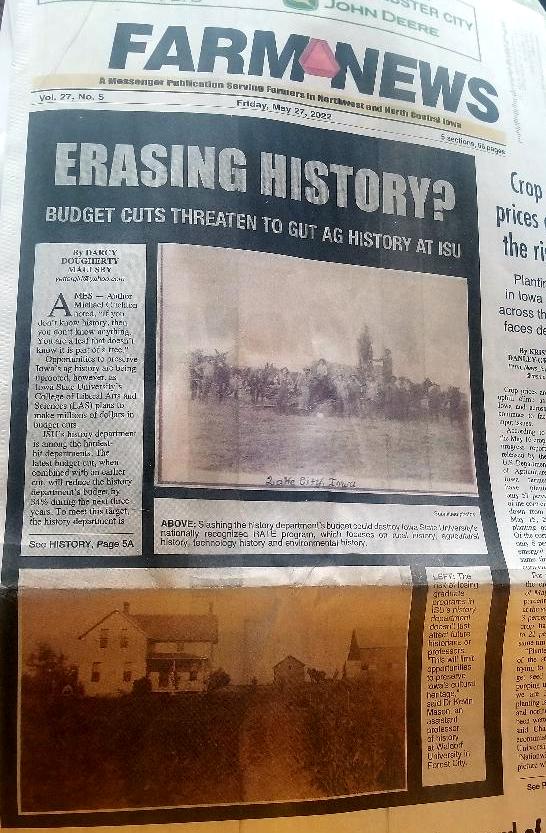
Erasing History? Budget Cuts Threaten to Gut Ag History at Iowa State University
Author Michael Crichton noted, “If you don’t know history, then you don’t know anything. You are a leaf that doesn’t know it is part of a tree.” Opportunities to preserve Iowa’s ag history are being uprooted, however, as Iowa State University’s (ISU) College of Liberal Arts and Sciences (LAS) plans to make millions of dollars in budget cuts.
ISU’s history department is among the hardest-hit departments. The latest budget cut, when combined with an earlier cut, will reduce the history department’s budget by 34% during the next three years. To meet this target, the history department is considering eliminating its graduate programs and search for further economies.
“The decisions made today influence the future,” said Michael M. Belding III, 31, a Ph.D. candidate studying rural, agricultural, technological, and environmental history at ISU. “I disagree with the budget cuts for ISU’s history department, because the people of Iowa deserve better.”
Belding has been gathering signatures to challenge these budget cuts, which would eliminate graduate programs in ISU’s history department.

Michael M. Belding III, a Ph.D. candidate studying rural, agricultural, technological, and environmental history at Iowa State University (ISU), has been gathering signatures to challenge severe budget cuts that would eliminate graduate programs in ISU’s history department.
He took action after Dr. Beate Schmittmann, LAS dean, announced a new round of budget cuts as part of her “Reimagining LAS” initiative. This is intended to “right-size” the budget in response to changing enrollment and student demand and “to position the college for future success,” according to ISU.
Slashing the history department’s budget will destroy ISU’s nationally-recognized RATE program, which focuses on rural history, agricultural history, technology history and environmental history. “If these proposed budget cuts occur, ISU is throwing away an innovative, important program,” noted Dr. Pamela Riney-Kehrberg, a distinguished professor of history at ISU.
If this happens, there will be long-lasting, negative impacts for Iowa, added Dr. Joe Anderson, a professor of history at Mount Royal University in Calgary, Alberta. “The Midwest has long been dynamic powerhouse of agriculture and innovation,” said Anderson, who earned his Ph.D. in history at ISU. “Everyone who cares about Iowa and its past should be mad as hell about ISU’s decision.”
Iowa’s ag heritage isn’t just for history majors
The risk of losing graduate programs in ISU’s history department doesn’t just affect future historians or professors. “This will limit opportunities to preserve Iowa’s cultural heritage,” said Dr. Kevin Mason, an assistant professor of history at Waldorf University in Forest City.
Not everyone who enrolls in history classes at ISU is a history major, added Mason, who received his Ph.D. in rural and environmental history from ISU in 2020. They include attorneys, engineers, architects and high school teachers who want to expand their knowledge of Iowa’s heritage. “If you care about Iowa history, you need to understand ag history.”
The only other university offering anything similar to ISU’s RATE program is Mississippi State University (MSU), although MSU focuses on Southern—not Midwestern—history. Neither the University of Iowa nor the University of Northern Iowa focus on ag/rural history, Riney-Kehrberg added.
“In most history courses and books, there’s little or no information on ag history following the Civil War,” noted Riney-Kehrberg, who researches American rural and agricultural history and will soon publish her latest book, When a Dream Dies: Agriculture, Iowa and the Farm Crisis of the 1980s. “The standard American history textbook might have one sentence about the Farm Crisis.”
The same dearth of information is evident when it comes to the role of women in agriculture. “There are many women’s studies courses today, but they often only teach the story of urban women, not rural women,” Riney-Kehrberg added.

“If these proposed budget cuts occur, ISU is throwing away an innovative, important program,” notes Dr. Pamela Riney-Kehrberg, a distinguished professor of history at Iowa State University.
History comes to life through the “land-grant land hunt”
While Yale University offers agrarian studies, it’s not the boots-on-the-ground style of research and extension that a land-grant university like ISU provides, Riney-Kehrberg noted.
Brandon Duxbury experienced this first-hand through the “land-grant land hunt” that ISU Extension undertook from 2014-2018. Contrary to popular belief, not a single acre of Story County land was given to Iowa State as part of the land-grant act (the Morrill Act) of 1862. Iowa was the first state to accept the provisions of the Morrill Act to build a college for the study of agriculture and the mechanical arts. Iowa Governor Samuel Kirkwood appointed Peter Melendy to select the best 210,000 acres of Iowa land to fund the new land-grant college. Most of this land was available in north-central and northwest Iowa.
Iowa became the first state to digitally map all these land-grant parcels within the state. Duxbury, a South Dakota native and graduate student in ISU’s history program, researched countless historical documents and interviewed current landowners to share their stories of their farmland. “People were always excited when we contacted them about this project,” said Duxbury, who is the new curator of collections at the Dacotah Prairie Museum in Aberdeen, South Dakota.
These stories, videos, a digital map and more can be found at www.landgrant.iastate.edu. “Efforts like this inspire people to ask better questions about the legacy they’re leaving with the land,” Duxbury said.
Making Iowa history relevant in ways like this is vital, said Belding, a Story City native who has links to his petitions on his Twitter account @mickey_belding. “I grew up thinking history involved big events that happened elsewhere, not here in Iowa. The more I research Iowa’s ag history, though, the more attached I get to Iowa.”
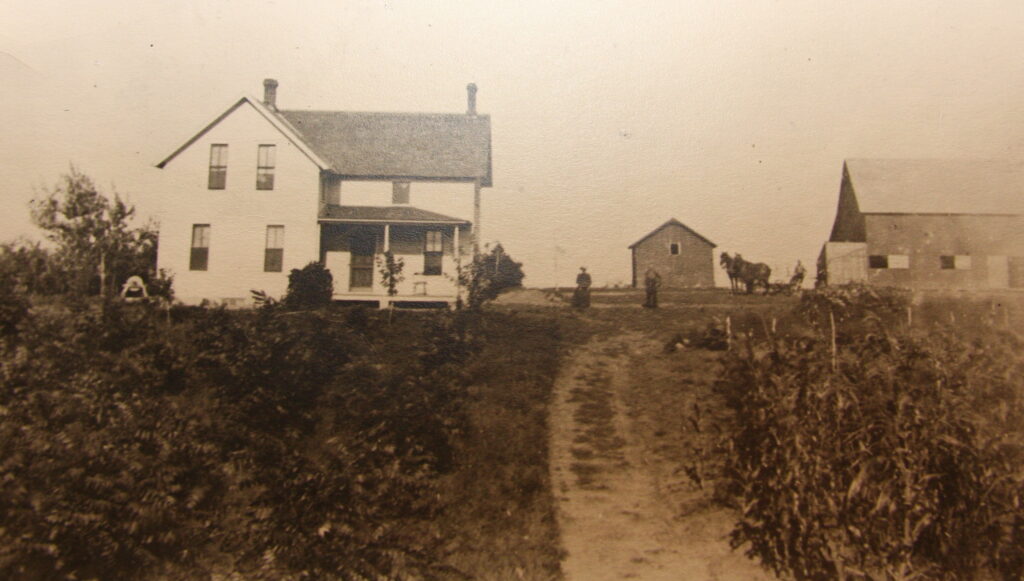
Family farms like this one near Yetter in Calhoun County have driven the economy in Iowa and the Midwest for generations. “The Midwest has long been dynamic powerhouse of agriculture and innovation,” says Dr. Joe Anderson, a professor of history at Mount Royal University in Calgary, Alberta, who earned his Ph.D. in history at Iowa State University (ISU). “Everyone who cares about Iowa and its past should be mad as hell about ISU’s decision.”
Teaching history prepares students for success
Along with researching and preserving Iowa history, ISU’s history department helps students develop a broad skill set, including communication. “My dad was a computer programmer who was promoted to management,” Riney-Kehrberg said. “He always emphasized that reading, writing and speaking skills were essential for a successful career.”
History classes also teach students research skills, data analysis and critical thinking. “You have to make an argument, and then find facts to support this argument,” Riney-Kehrberg said. “All this requires you to think carefully and broadly.”
Studies show that students with a solid LAS education, including history, have some of the best outcomes five years after college graduation. “These graduates tend to make more money, are the least likely to be fired, are less likely to move back home to live with their parents and are more likely to be promoted,” said Anderson, citing sources like the 2018 report “Humans Wanted: The Coming Skills Revolution,” published by the Royal Bank of Canada. “We’re very short-sighted as a culture if we devalue skills that come from studying the humanities.”
The “soft skills” of how people communicate with each other, interact with colleagues and solve problems are just as important to workplace readiness and employability as hard skills, especially as technology evolves. “It doesn’t take a ‘George Jetson’ moment to imagine a day when artificial intelligence and other technologies will replace some of the jobs we currently train people for,” Anderson, who served as director of history and interpretation at Living History Farms in Urbandale in the 1990s. “Our society will always need people who are skilled in human connection and communication.”
Society also needs educated citizens, both rural and urban, with a solid understanding of agricultural history, Anderson added. “People who are trained in ISU’s history department often go on to run museums in Iowa and the Midwest, teach at community colleges like DMACC or Hawkeye Community College, teach at land-grant universities, or pursue a variety of other careers.”
Everywhere they go, these professionals take Iowa history with them, noted Anderson, a south-central Nebraska native who loved spending time on his grandparents’ farms in Missouri and Iowa. He often incorporates Midwestern history into the classes he teaches in Canada. “This perspective helps people better understand many pressing issues today, from water quality to food production.”
Integrating history with tourism, economic development
It’s essential to be open to new ways of making Iowa history relevant to a wider audience, Mason said. “I believe history departments, especially at a land-grant like ISU, can collaborate across academic disciplines to help create a more diversified economy that encourages young people to stay in Iowa.”
Mason, who grew up in Pella, saw how Iowa history was intertwined with job creation, economic development and tourism in his hometown. “Tradition is important in Pella. Honoring this heritage helps young people gain a sense of place and the sense of pride that comes from knowing their history.”
Anyone who is concerned about the proposed funding cuts to ISU’s history department should contact their state legislators, the Board of Regents, and Dr. Beate Schmittmann, dean of the College of LAS at ISU. It’s important to take action now, Duxbury said. “The loss of ISU’s graduate history programs is a loss to Iowa history. Fighting these drastic cuts is a battle worth fighting.”
Note: I wrote this article for Farm News. It first appeared in the Friday, May 27, 2022, edition of Farm News. I’ve had a number of people ask me what they can do to fight these budget cuts. First, if you’re an Iowan, contact the senator and representative who represent you at the state level in the Iowa legislature. Also, contact leaders at ISU, including:
Iowa State University
Attn. Dr. Beate Schmittmann
202 Catt
2224 Osborn Dr.
Ames IA 50011-4009
Iowa State University
Office of the President, Dr. Wendy Wintersteen
515 Morrill Road
1750 Beardshear Hall
Ames, IA 50011
Want more?
I invite you to read more of my blog posts if you value intriguing Iowa stories and history, along with Iowa food, agriculture updates, recipes and tips to make you a better communicator.
If you’re hungry for more stories of Iowa history, check out my top-selling “Culinary History of Iowa: Sweet Corn, Pork Tenderloins, Maid-Rites and More” book from The History Press. Also take a look at my other books, including “Iowa Agriculture: A History of Farming, Family and Food” from The History Press, “Madison County,” “Dallas County” and “Calhoun County” book from Arcadia Publishing. All are filled with vintage photos and compelling stories that showcase the history of small-town and rural Iowa. Click here to order your signed copies today! Iowa postcards are available in my online store, too.
If you like what you see and want to be notified when I post new stories, be sure to click on the “subscribe to blog updates/newsletter” button at the top of this page, or click here. Feel free to share this with friends and colleagues who might be interested, too.
Also, if you or someone you know could use my writing services (I’m not only Iowa’s storyteller, but a professionally-trained journalist with 20 years of experience), let’s talk. I work with businesses and organizations within Iowa and across the country to unleash the power of great storytelling to define their brand and connect with their audience through clear, compelling blog posts, articles, news releases, feature stories, newsletter articles, social media, video scripts, and photography. Learn more at www.darcymaulsby.com, or e-mail me at yettergirl@yahoo.com.
Let’s stay in touch. I’m at darcy@darcymaulsby.com, and yettergirl@yahoo.com.
Talk to you soon!

Machines that Changed America: John Froelich Invents the First Tractor in Iowa
Today, it’s hard to imagine a cornfield without a tractor in the picture. I was thinking about tractor history when The History Channel featured “The Machines That Built America.” I was glad to see they included the story of John Froelich, which I featured in my 2020 book Iowa Agriculture: A History of Farming, Family and Food.
Here’s an excerpt:
Back in 1892 in the tiny village of Froelich in Clayton County, Iowa, however, folks were amused by what a local businessman, John Froelich, was saying.
This northeast Iowa entrepreneur (1849 -1933) believed that mechanical power had a great future—that someday traction engines would do the work of horses even on mid-sized and large farms. The locals had to admit, though, that Froelich had invented several handy gadgets, including a more efficient washing machine, plus he was a good businessman.
Froelich ran a grain elevator, plus he ran a well-digging business and operated a threshing rig. Every year he took a crew of men to Langford, South Dakota, to work the fields. Froelich had considerable experience with steam engines and knew their pitfalls. They were heavy and bulky. They were hard to maneuver. They were always threatening to set fire to the grain and stubble fields. On the flat prairie, with a strong wind blowing, that was no joke.
A frustrated Froelich decided he could invent a better way to power the engine. The solution was gasoline. Froelich and local blacksmith Will Mann came up a vertical, one-cylinder engine mounted on the running gear of a steam traction engine – a hybrid of their own making. They designed many new parts to make it all fit together, but it finally was done. The word “tractor” wasn’t used in those days, but that’s what Froelich invented.
A few weeks later Froelich and his crew started for the broad fields of South Dakota with the “tractor” and a new threshing machine. That fall they threshed 72,000 bushels of small grain. It was a success!
Later that fall, Froelich shipped his “tractor” to Waterloo, Iowa, to show some businessmen. Immediately, the men formed a company to manufacture the “Froelich Tractor.” They named the company The Waterloo Gasoline Traction Engine Company and made Froelich the president.
Unfortunately, efforts to sell the practical, gasoline-powered tractor failed. Two were sold and shortly returned. The company then decided to manufacture stationary gas engines to provide income while tractor experiments continued, according to the Froelich Museum.
In 1895, the Waterloo Gasoline Engine Company was incorporated, but Froelich, whose interest was in tractors, not stationary engines, chose to withdraw from the company. The Waterloo Company continued to build stationary engines while trying to improve the tractor. In 1913 the model “L-A” was made.
In 1914, the first Waterloo Boy tractor, the Model “R” single-speed tractor, was introduced. Farmers liked it, and sales reached 118 within a year. When the Model “N” Waterloo Boy with two forward speeds was introduced, it was also successful.
When World War I led to rising farm prices and strong demand for dependable mechanical farm power, the concept of the tractor became so popular many tractor manufacturers sprung up in a matter of months. Deere and Company in Moline, Illinois, which manufactured a full line of John Deere implements, had been watching the progress of the Waterloo Engine Company and the increasing quality of its products.
Deere was looking for an established farm tractor to round out its line, and the Waterloo Engine Company fit the bill. Today, Deere’s facility in Waterloo remains one of the largest tractor-producing plants in the nation.
Tractors of various types and sizes that make farming easier and more efficient are shipped to farmers all over the world. For this contribution, John Froelich will long be remembered, and the village of Froelich, Iowa, remains “Tractor Town U.S.A.”
Tractor enthusiasts from around the globe travel to this tiny village to visit the birthplace of the tractor. At the 1891 general store, guests can view a scale model of the first “Froelich Tractor” made from the original blueprints. Perhaps the monument erected in 1939 near the general store best captures the essence of this unique place.
“In this village, John Froelich built the first gasoline tractor that propelled itself backwards as well as forward. Far-reaching in its effect on modern agricultural history, it moved out of this village and into the world in 1892. Later that year, Mr. Froelich joined with others in organizing the Waterloo Gasoline Traction Engine Company, which later became the John Deere Tractor Company.”
Meeting the challenge of a reliable, durable tractor
This history took center stage at the 2018 Iowa State Fair in Des Moines, when a butter sculpture of the Waterloo Boy Tractor stood next to the world-famous Butter Cow in the John Deere Agriculture Building’s 40-degree cooler throughout the fair, which ran from August 9-19.
To understand the significance of the Waterloo Boy, take a trip back in time, said Neil Dahlstrom, manager of the John Deere Archives and History. In the critical five-year stretch (1912-1917) prior to John Deere entering the tractor business, there were two key issues to address.
“First, what did farmers really want from a machine that would soon make the horse obsolete?” said Dahlstrom, who noted that salesmen, territory and branch managers, and Deere’s top leadership scoured the country to understand what customers desired. Also, how could the equipment to be manufactured to be durable enough to stand up to daily farm use?
Deere had considered every imaginable idea. The company had developed one-, two- and four-cylinder concept tractors. Some ran on gasoline. Others ran on kerosene. Some had all-wheel drive. Others had front-wheel drive. The company even explored concepts like line steering, which was meant to replicate horse reins as the steering mechanism to ease farmers into power farming, Dahlstrom said.
A motorized cultivator, what Deere called a “Tractivator,” was brought to market by several competitors, but Deere determined it did not provide any cost savings compared to horses.
The challenge of producing a durable tractor loomed large. In a letter to company president William Butterworth in 1915, Deere’s superintendent of factories George Mixter noted that tractors offered by competitors up to that point “have not been built with the proper spirit behind the design and manufacture to insure their durability in the hands of the farmers.” But if Deere could “build a small tractor that will really stand up for five or more years’ work on the farm, I believe they will be a permanent requirement of the American farmer,” Mixter wrote.
Deere ultimately found the solution with the Waterloo Boy tractor and acquired the Waterloo Gasoline Engine Company in Waterloo, Iowa, on March 14, 1918. Although anxious to start selling the Waterloo Boy, Deere dealers had to wait while Deere honored existing contracts, which did not expire until Dec. 31, 1918, Dahlstrom said.
Waterloo Boy makes its debut
Deere put its money where its instincts were. Over the next year, the company spent more than one-third of its advertising budget touting the Waterloo Boy tractor, Dahlstrom said.
Specifically, Deere invested $50,000 on tractor advertising in the year following its debut of the Waterloo Boy—approximately $747,000 in today’s money. Another way to get the company’s new product out in front of customers was to take it on the road – literally.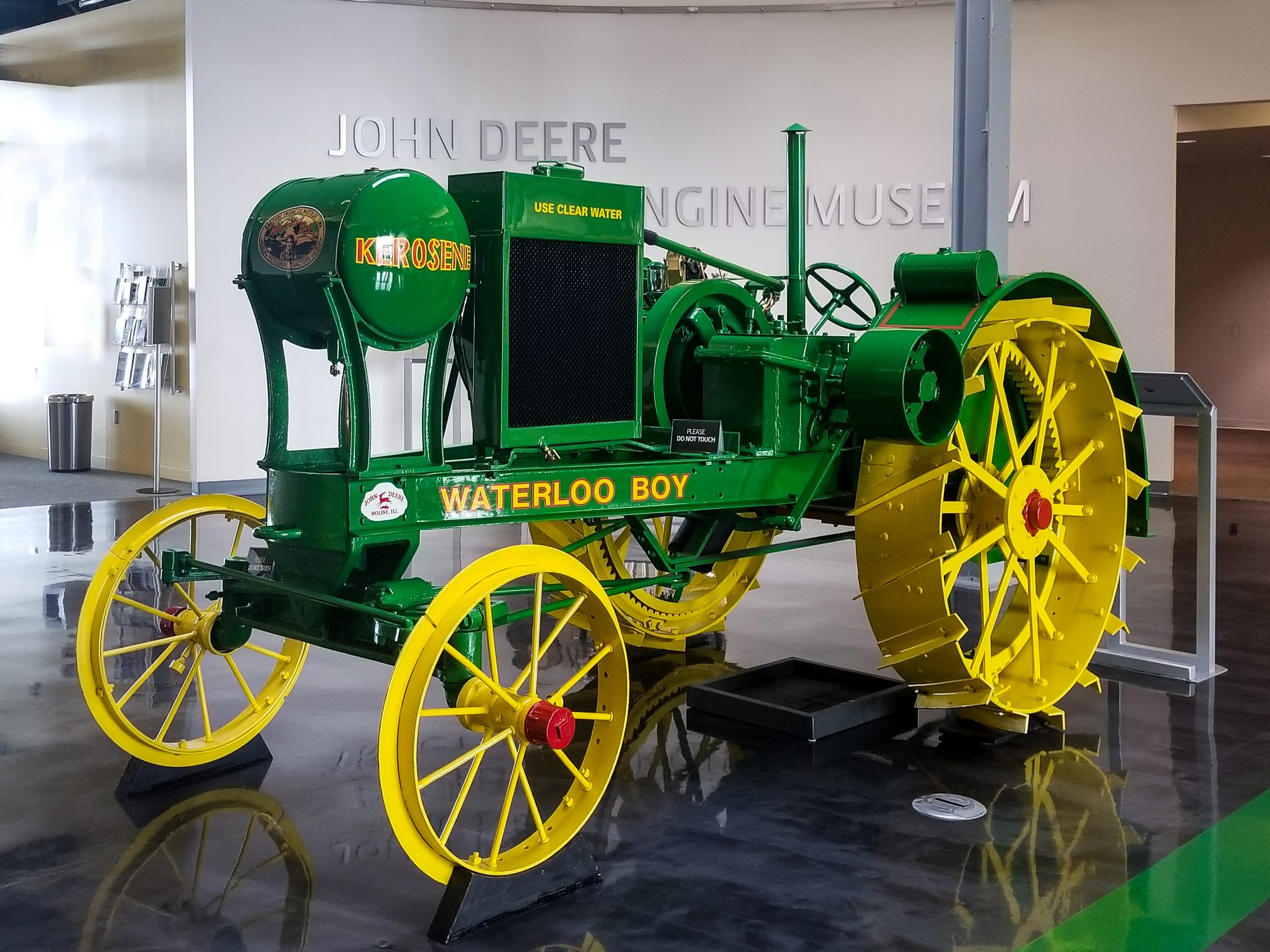 The National Tractor Demonstrations started to become more mainstream after being introduced in the United States in 1913. An eight-city, eight-week tour schedule was the perfect opportunity to unveil Deere’s Waterloo Boy, Dahlstrom said. Salina, Kansas, served as the ideal backdrop in August 1918, since this was the nation’s largest demonstration.
The National Tractor Demonstrations started to become more mainstream after being introduced in the United States in 1913. An eight-city, eight-week tour schedule was the perfect opportunity to unveil Deere’s Waterloo Boy, Dahlstrom said. Salina, Kansas, served as the ideal backdrop in August 1918, since this was the nation’s largest demonstration.
Deere had participated in tractor demonstrations since the original Winnipeg Agricultural Motor Competitions in Manitoba, Canada, in 1908 – but not with a tractor. Instead, Deere had paired its plows with leading tractor manufacturers. That changed now that the Waterloo Boy was part of the Deere family.
At Salina, Deere spared no expense, showcasing 12 Waterloo Boy tractors as the centerpiece of a display that included John Deere signs, Waterloo Boy signs and a copper leaping deer statue, Dahlstrom said. “There were two stars during this week of 100-degree days – ‘ice water on tap’ and the Waterloo Boy Model ‘N’ tractor,” he added.
The Model “N” demonstrated its merits by pulling tractor plows, disc harrows and grain drills. Visitors were shuttled in three John Deere farm wagons pulled by Waterloo Boy tractors. By all accounts, the debut was a success.
“The award for the most elaborate, largest and most artistic exhibit tent at the Salina tractor show will undoubtedly go to the John Deere Plow company of Kansas City,” wrote the editors of a Kansas City newspaper.
As Deere’s advertising campaign swung into full gear, the Waterloo Boy tractor was promoted as the “best and most efficient tractor” on the market for farmers inclined to buy a tractor. By October 1918, readers of Deere’s magazine, The Furrow, saw an advertisement for the line of Waterloo Boy tractors and stationary engines. The ad guaranteed the Waterloo Boy’s “ample power for field and belt work.”
In January 1919, with tractors now available through John Deere dealers, Deere’s first print ad for the trade press appeared in The Farm Implement News. It featured two areas of emphasis: “A Good Tractor Backed by a Permanent Organization.”
After years of development, John Deere customers and John Deere dealers finally had their John Deere tractor. “It took longer than the company expected, but a determination to do it right instead of doing it fast now brought the John Deere tractor to market,” Dahlstrom said.
As a result, customers got “the assurance of more tractor work per dollar of fuel cost; longer tractor life with less repair cost; accessibility of parts that makes caring for the tractor simple and easy; and dependable power for all farm work.”
The tractor era had officially arrived, and Iowa found itself at the epicenter of this growing industry.
Want more?
I invite you to read more of my blog posts if you value intriguing Iowa stories and history, along with Iowa food, agriculture updates, recipes and tips to make you a better communicator.
If you’re hungry for more stories of Iowa history, check out my top-selling “Culinary History of Iowa: Sweet Corn, Pork Tenderloins, Maid-Rites and More” book from The History Press. Also take a look at my other books, including “Iowa Agriculture: A History of Farming, Family and Food” from The History Press, “Madison County,” “Dallas County” and “Calhoun County” book from Arcadia Publishing. All are filled with vintage photos and compelling stories that showcase the history of small-town and rural Iowa. Click here to order your signed copies today! Iowa postcards are available in my online store, too.
If you like what you see and want to be notified when I post new stories, be sure to click on the “subscribe to blog updates/newsletter” button at the top of this page, or click here. Feel free to share this with friends and colleagues who might be interested, too.
Also, if you or someone you know could use my writing services (I’m not only Iowa’s storyteller, but a professionally-trained journalist with 20 years of experience), let’s talk. I work with businesses and organizations within Iowa and across the country to unleash the power of great storytelling to define their brand and connect with their audience through clear, compelling blog posts, articles, news releases, feature stories, newsletter articles, social media, video scripts, and photography. Learn more at www.darcymaulsby.com, or e-mail me at yettergirl@yahoo.com.
Let’s stay in touch. I’m at darcy@darcymaulsby.com, and yettergirl@yahoo.com.
Talk to you soon!

Bob Feller on Farming, Baseball and Military Service
Now that we’re in the time of the year when we take time to honor those who’ve served (Memorial Day), celebrate America (July 4) and maybe even catch a baseball game, I think about the time I interviewed Bob Feller, a Major League Baseball legend and Iowa farm kid.
I’m willing to bet that most people, if they are old enough to remember Feller, know him more for his pitching prowess with the Cleveland Indians. But Feller was also a decorated World War II veteran who gave up some of his prime years of playing professional baseball to serve his country.
“I’m very proud of our military and have a lot of respect for our troops,” said Feller (1918-2010) when I interviewed him in his hometown of Van Meter, Iowa, in 2003.
Known as the “Heater from Van Meter,” Feller signed a pro baseball contract with the Cleveland Indians when he was only 16. “Farm work made me a ball player,” Feller said. “When I was little, I was the water boy for the threshing crew. As I got older, I did it all—I cleaned the barn, milked cows, drove tractors and teams of horses, picked corn and threw bales of hay. Those bales really helped strengthen my arms.”
Feller’s father, Bill, was his first coach. “When I was a kid, Dad built a ball field we called Oak View. That was the first Field of Dreams—not that one from the movies.”
Feller grew up playing baseball at vacation Bible school at the Methodist Church in Van Meter. He also played four years of American Legion baseball in Adel, where his catcher was Nile Kinnick, a future University of Iowa football star who would enlist in the Navy Air Corps Reserve three days after the attacks on Pearl Harbor.
Feller’s father spent hours helping his son develop his baseball skills. “Dad would hit ground balls to me in the hog lot and pitch batting practice to me. We’d practice every night we could. When Mom would call us for supper, we’d always tell her we could eat after dark, but we couldn’t play ball after dark.”
“I never thought twice about enlisting”
By the time Feller played his first game in the major leagues in 1936, the teenaged pitcher struck out 15 St. Louis Browns. Later that season, at age 17, Feller set a new American League record by fanning (striking out) 17 Philadelphia Athletics. In Chicago in 1940, Feller pitched his first of three no-hitters and the only no-hitter pitched on opening day in major league history.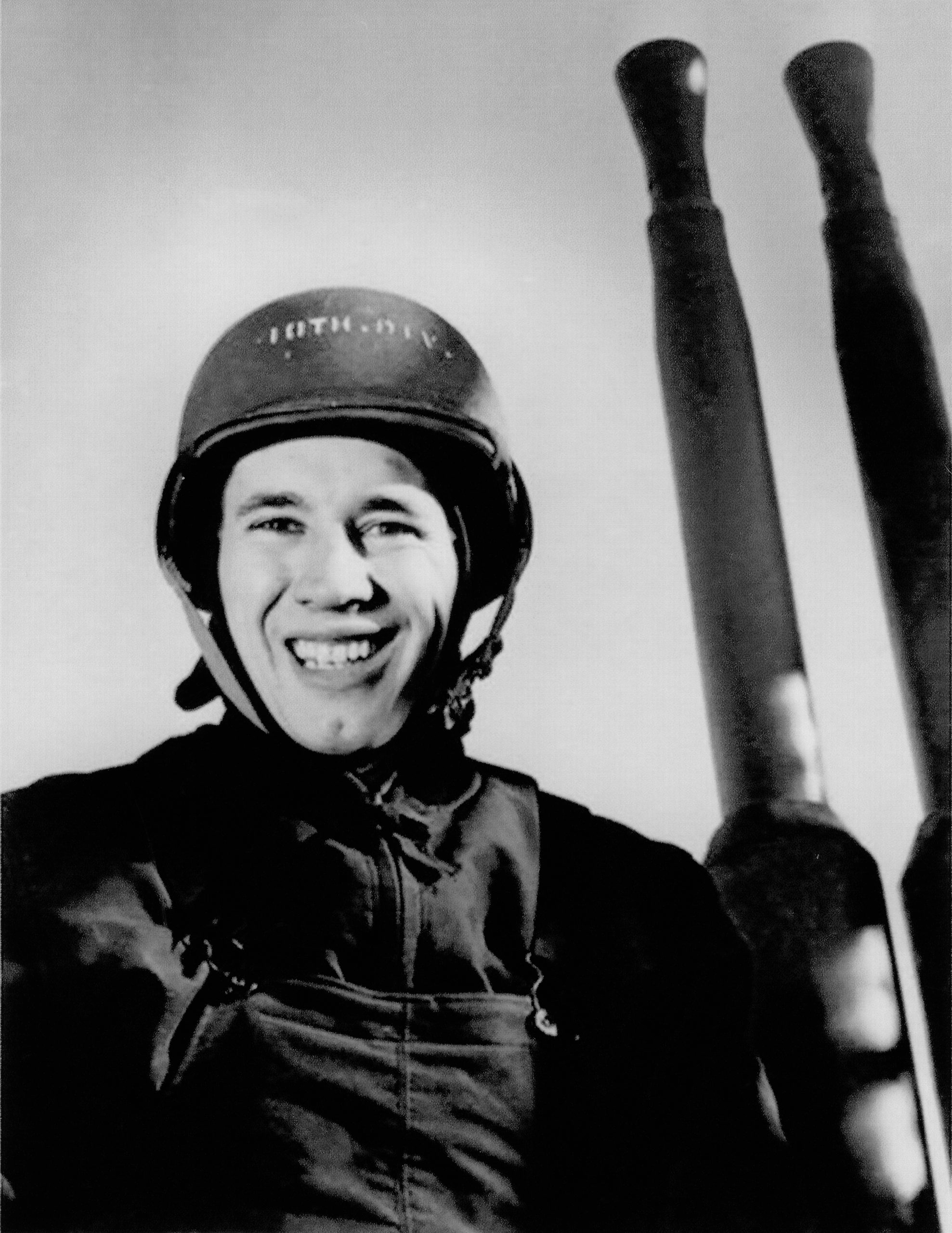 On the eve of World War II, Feller was playing in the big leagues with stars like Ted Williams and Joe DiMaggio. By the time Feller enlisted in the Navy two days after the Pearl Harbor attacks on December 7, 1941, the 22-year-old star had already set a number of major league records.
On the eve of World War II, Feller was playing in the big leagues with stars like Ted Williams and Joe DiMaggio. By the time Feller enlisted in the Navy two days after the Pearl Harbor attacks on December 7, 1941, the 22-year-old star had already set a number of major league records.
While some say Feller’s military service took away what could have been some of his most productive years, Feller doesn’t see it that way.
“I never thought twice about enlisting. I played a little baseball during boot camp in Norfolk, Virginia, before I became an anti-aircraft gun captain on the USS Alabama for 34 months.”
Feller was awarded eight Battle Stars during his years of service. When the war ended, Feller resumed his baseball career with the Cleveland Indians in the late summer of 1945. “I’m no hero,” emphasized Feller, who was inducted into the Hall of Fame in 1962, after retiring from baseball in 1956 at age 37. “I’m just a survivor. The men who never returned home to this country were the heroes.”
Maybe Feller’s story resonates me so much because I, too, come from rural Iowa, and I’ve been blessed to know many friends and family members who have served our country. America is home to a significant percentage of veterans. In 2011–2015, nearly one fourth (24.1 percent) of the veteran population 18 years and older lived in areas designated as rural, according to census.gov.
While we don’t know them all, we owe them all. Thanks to you all, and thanks to patriots like Bob Feller who was willing to serve when his country needed him. America truly is the home of the free because of the brave.
Want more?
I invite you to read more of my blog posts if you value intriguing Iowa stories and history, along with Iowa food, agriculture updates, recipes and tips to make you a better communicator.
I’ve shared more Bob Feller stories and photos in my Iowa history book “Dallas County.”
If you’re hungry for more stories of Iowa history, check out my top-selling “Culinary History of Iowa: Sweet Corn, Pork Tenderloins, Maid-Rites and More” book from The History Press. Also take a look at my other books, including “Iowa Agriculture: A History of Farming, Family and Food” from The History Press, “Madison County,” “Dallas County” and “Calhoun County” book from Arcadia Publishing. All are filled with vintage photos and compelling stories that showcase the history of small-town and rural Iowa. Click here to order your signed copies today! Iowa postcards are available in my online store, too.
If you like what you see and want to be notified when I post new stories, be sure to click on the “subscribe to blog updates/newsletter” button at the top of this page, or click here. Feel free to share this with friends and colleagues who might be interested, too.
Also, if you or someone you know could use my writing services (I’m not only Iowa’s storyteller, but a professionally-trained journalist with 20 years of experience), let’s talk. I work with businesses and organizations within Iowa and across the country to unleash the power of great storytelling to define their brand and connect with their audience through clear, compelling blog posts, articles, news releases, feature stories, newsletter articles, social media, video scripts, and photography. Learn more at www.darcymaulsby.com, or e-mail me at yettergirl@yahoo.com.
Let’s stay in touch. I’m at darcy@darcymaulsby.com, and yettergirl@yahoo.com.
Talk to you soon!

Classic Restaurants of Des Moines: A Taste of Thailand Served the “Publics” and Politics
Have you ever seen a bird fly backwards? Are you able to touch your toes? Whom will you vote for? All this and more defined A Taste of Thailand, a classic restaurant of Des Moines. This may have been the only restaurant in the world with a home-made voting booth. The quixotic T.O.T. Polls (Taste of Thailand) polls and the delicious Thai food practically made A Taste of Thailand a mandatory stop for presidential candidates and reporters covering the Iowa caucus.
The Taste of Thailand in downtown Des Moines became a dining destination during the 1980s for locals and visitors. Thai natives Prasong “Pak” Nurack and Benchung “Beni” Laungaram, his wife, opened their popular restaurant in December 1983, in an abandoned auto repair shop, repainted bright yellow. “So the publics will know we are here,” Pak said.
It may have been the only restaurant in the world with a home-made voting booth. The quixotic T.O.T. Polls (Taste of Thailand) polls and the delicious Thai food practically made A Taste of Thailand a mandatory stop for presidential candidates and reporters.
Years before Pak opened Des Moines’ original Thai restaurant, and decades before Pak would become a Thai national senator, he ran a diner on Court Avenue called Little Joe’s. Thai cuisine was a new thing in Des Moines when Pak and his wife introduced their native food on weekends at Little Joe’s.
In the late 1970s, most Iowans knew little about south and southeast Asian cuisines, noted Jim Duncan, a food writer from Des Moines. Pak, however, was a big personality who could easily talk people into trying something new.
He later moved his family’s restaurant to a place in the 200 block of East Walnut in Des Moines, opened another restaurant in Iowa City and eventually returned to Asia to pursue his political career in Thailand’s Senate.
Before that, however, Pak began capturing media attention in the mid-1980s for his distinctive food and his restaurant’s political flair.
“Candidates, news organizations and special-interest groups have spent thousands of dollars on polls trying to determine which men Iowa caucus-goers will anoint as front-runners for the 1988 presidential nominations,” noted the Chicago Tribune in the November 24, 1987, article “Forget Costly Polls: Eat Thai to Find Out Who’s Winning Iowa.” “They could have saved a lot of money and gotten a good meal in the process by checking out the results posted on a wall of the one and only Thai restaurant in the capital of cornfed beef.”
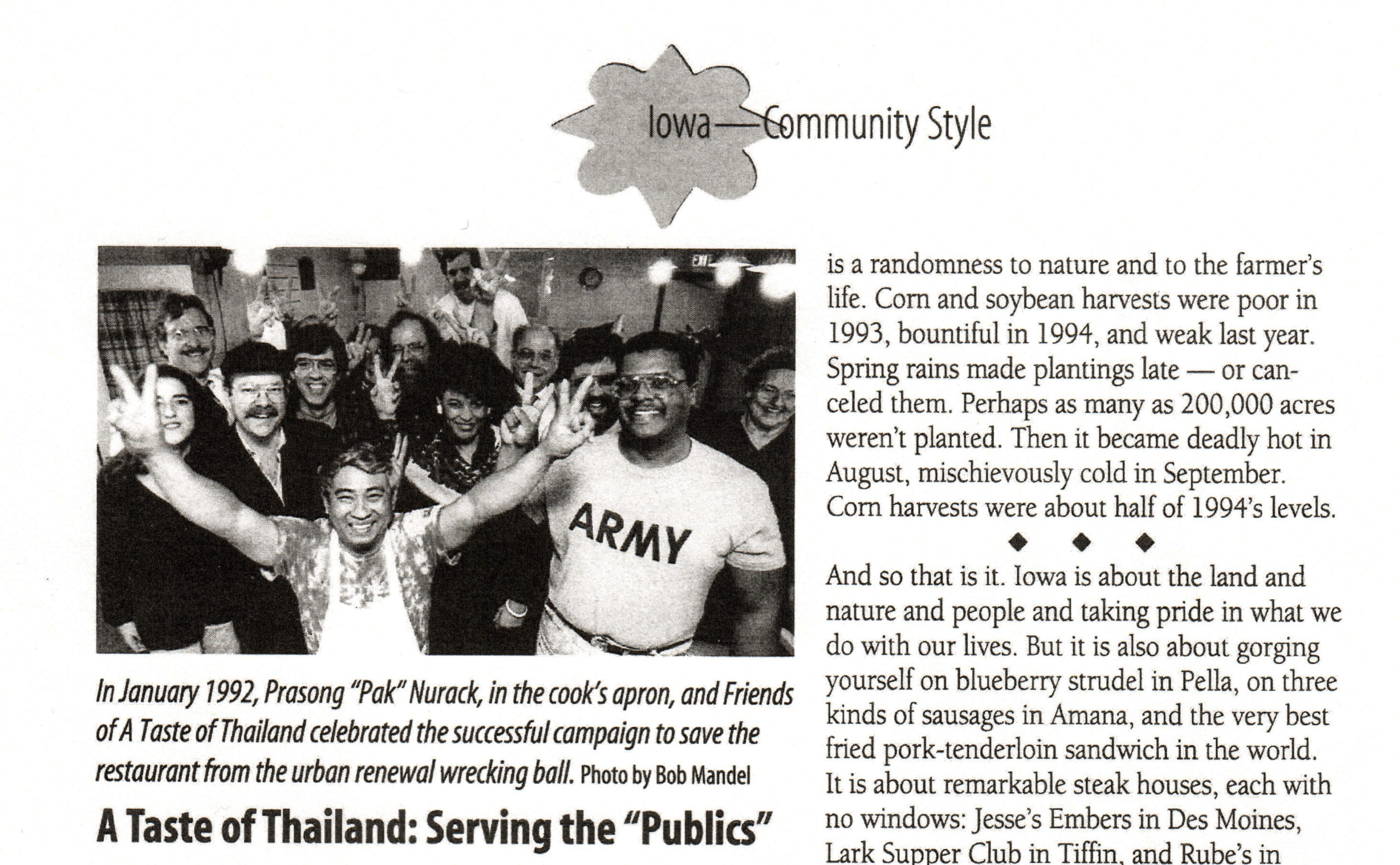 The article noted Pak, 45, was a lawyer who held a masters degree in political science. His bright yellow restaurant, located in the shadow of the gold-domed state capitol, was frequented by politicos, activists and others lured by the food and informal polls. Diners at Taste of Thailand received a ballot with the menu and could vote at the table or in a makeshift voting booth. Ballots were then placed in a box next to one poster showing the most recent results and another that said, “Road to the,” and then featured a picture of the White House.
The article noted Pak, 45, was a lawyer who held a masters degree in political science. His bright yellow restaurant, located in the shadow of the gold-domed state capitol, was frequented by politicos, activists and others lured by the food and informal polls. Diners at Taste of Thailand received a ballot with the menu and could vote at the table or in a makeshift voting booth. Ballots were then placed in a box next to one poster showing the most recent results and another that said, “Road to the,” and then featured a picture of the White House.
Pak insisted there is no ballot stuffing. ”I tell them to look at the ballot box where it says ‘honesty’ on it,” he told the Chicago Tribune. “And I tell them: Please, just one vote.’” He also supplies real voter registration cards. With his low-tech sampling process, Pak could be surprising accurate with polling results.
“About a week before the most recent CBS-New York Times poll and three weeks before the most recent Des Moines Register Iowa Poll, the unscientific sample of diners at the Taste of Thailand restaurant had determined that Sen. Paul Simon (a Democrat from Illinois) and Sen. Bob Dole (a Republican from Kansas) were the choice of the moment in their respective parties,” the Chicago Tribune noted in 1987. Dole would win the 1988 Iowa caucus on the Republican side, while Simon would finish a fairly close second that year to Rep. Richard Gephardt, a Democrat from Missouri.
Three candidates came to call on Pak personally in 1987, including Sen. Simon, Sen. Joseph Biden (a Democrat from Delaware), and Republican Alexander Haig, the U.S. Secretary of State under President Ronald Reagan and the White House chief of staff under presidents Richard Nixon and Gerald Ford. “But the restaurateur has withheld endorsement, saying he didn’t want to influence the poll,” the Chicago Tribune noted. Pak did say Haig showed “courage for coming to a restaurant where most of the patrons are liberal and Democrat.”
“Nobody lies”
How did a unique character like Pak come to Des Moines? When he was a lawyer in Thailand, Pak had dreamed of touring America after reading about it in books and seeing it on the news.
He moved to Chicago in 1971 to study political science. “I like politics, and you learn that all the players in the world know about politics in the United States,” Pak told the Chicago Tribune. “I wanted to learn something more.”
He worked part time washing dishes at the Rodeway Inn near O’Hare International Airport while he earned his masters degree in political science from Northeastern Illinois University. While Pak and his wife considered going back to Thailand, they wanted to see what smaller towns were like and headed west from Chicago. “This was the first big town we found,” he said of Des Moines. “We decided to stay. Its an agricultural town and instead of rice fields, we see cornfields. That’s nice.”
Pak and his wife became acquainted with many people in Des Moines. “They are interesting people. We talked issues over and we had something in common.”
It was during the discussions with patrons that Pak decided to conduct an informal poll of public opinion, partly as a marketing device for his restaurant and partly to keep discussions of current issues alive.
Fascinated by American politics, Pak decided to begin a monthly poll in 1986. He started asking serious and not-so-serious questions, ranging from people’s feelings about Farm Crisis to their favorite pet. The move to presidential politics was a natural next step. “People come here to eat, but they talk about politics,” Pak said.
Amazingly, the results of Taste of Thailand Polls have never been far off from more established surveys. A New York Times/CBS News survey released Oct. 31, 1987, for example, showed that Sen. Paul Simon had made a dramatic leap and was edging ahead of the Democratic presidential pack in Iowa for the first time, reported the November 27, 1987, issue of the New York Times.
“The Taste of Thailand poll showed the same thing a week earlier,” Maureen Dowd noted in her article “Iowa Restaurant Serves Up Sweet and Sour Poll Results.”
“We get pretty good information,” the “ebullient” Pak told Dowd. “’Nobody lies.”
The newspaper explained how Taste of Thailand, which featured a cosmopolitan beer list of 259 brands from 36 countries, catered to presidential candidates, political operatives, city and state officials, journalists and lobbyists for farm groups. “This,” Pak said, pulling out a camera to take a few candid shots of a CNN-TV crew having dinner, “is the same camera that took pictures of Joe Biden and Paul Simon eating here.” During Taste of Thailand’s polls, patrons wrote down their political preferences, either in the privacy of the restaurant’s curtained polling booth or in the more convivial atmosphere of their tables.
During Taste of Thailand’s polls, patrons wrote down their political preferences, either in the privacy of the restaurant’s curtained polling booth or in the more convivial atmosphere of their tables.
While the Taste of Thailand’s political polls drew the New York Times’ interest, Dowd couldn’t resist sharing results from the restaurant’s general-interest polls. People were interested in talking about reincarnation (37 percent of those polled at Taste of Thailand believed in it); television shows and talk show hosts (67 percent said they preferred ”MAS*H” to Johnny Carson); touching your toes (76 percent replied they could do it and 24 percent, presumably out-of-shape respondents, called it a silly question), and where disgraced televangelists Jim and Tammy Bakker will end up (the majority felt that Switzerland, rather than heaven or hell, was their destination).
No matter your opinion on politics or other pressing issues of the day, everyone agreed on two things. Taste of Thailand’s food was great, and it could be HOT.
“Taste of Thailand was the place to be,” recalled John Busbee, who hosts the Culture Buzz show on 98.9 KFMG Radio in Des Moines every Wednesday from 11 a.m. to 1 p.m.
While Busbee preferred to stick to chicken and vegetable dishes, adventurous eaters could find plenty of excitement. On the statistically coldest day each year in Des Moines (which usually occurred in February), the restaurant sponsored International Hot and Spicy Food Day. Pak and his team offered a buffet with all the hot food you could eat, along with all the cold beer you could drink.
You even had to sign a waiver stating you knew what you were getting into if you chose to try to the buffet, as if names of foods like “suicidal beef” and “angry shrimp” weren’t a big enough clue. “I enjoy spicy food, but that was way too much,” Chef Formaro said.
It’s hard to forget Taste of Thailand’s spicy food, said Coleen (Hildreth) Myers, who grew up in Lake City, Iowa, and now lives in Ankeny. In the late 1980s, Myers’ friend from India married a man from Thailand. She became acquainted with the couple at Iowa State University in Ames. Myers was invited to the couple’s wedding at the Episcopalian church in downtown Des Moines, as well as the reception, which included a sit-down dinner at Taste of Thailand.
“It was a very fancy dinner, and I vowed to try everything, but some of it was so hot that one bite was about all I could handle,” Myers said. “It was an experience I will never forget.”
Want more?
This story is just one of the many memories in my book Classic Restaurants of Des Moines and Their Recipes.” Check it out here.
I invite you to read more of my blog posts if you value intriguing Iowa stories and history, along with Iowa food, agriculture updates, recipes and tips to make you a better communicator.
If you’re hungry for more stories of Iowa history, check out my top-selling “Culinary History of Iowa: Sweet Corn, Pork Tenderloins, Maid-Rites and More” book from The History Press. Also take a look at my other books, including “Iowa Agriculture: A History of Farming, Family and Food” from The History Press, “Dallas County” and “Calhoun County” book from Arcadia Publishing. All are filled with vintage photos and compelling stories that showcase the history of small-town and rural Iowa. Click here to order your signed copies today! Iowa postcards are available in my online store, too.
If you like what you see and want to be notified when I post new stories, be sure to click on the “subscribe to blog updates/newsletter” button at the top of this page, or click here. Feel free to share this with friends and colleagues who might be interested, too.
Also, if you or someone you know could use my writing services (I’m not only Iowa’s storyteller, but a professionally-trained journalist with 20 years of experience), let’s talk. I work with businesses and organizations within Iowa and across the country to unleash the power of great storytelling to define their brand and connect with their audience through clear, compelling blog posts, articles, news releases, feature stories, newsletter articles, social media, video scripts, and photography. Learn more at www.darcymaulsby.com, or e-mail me at yettergirl@yahoo.com.
Let’s stay in touch. I’m at darcy@darcymaulsby.com, and yettergirl@yahoo.com.
Talk to you soon!

Remembering the African-American Sioux City Ghosts Fast-Pitch Softball Team
Even though owners and players of Major League Baseball are at an impasse trying to negotiate a 2020 season, there are still some noteworthy “boys of summer” stories to share, thanks to Iowa history. Perhaps no team brought more excitement to Iowa farm towns and cities across the country than the Sioux City Ghosts, a legendary African American fast-pitch softball team that got its start nearly 100 years ago.
“The Sioux City Ghosts were a big deal across the nation and internationally,” said Haley Aguirre, archival records clerk with the Sioux City Public Museum, which preserves some of the Ghosts’ history.
Because of their pranks on the softball field, the Sioux City Ghosts were often compared to the famous Harlem Globetrotters. The Sioux City team’s exceptional athletic skills, winning record and razzle-dazzle style of playing generated a level of excitement few teams have matched.
The team stemmed from a boys’ club the West 7th Street neighborhood of Sioux City, which was home to many African-American homes and businesses. This boys’ club team started with about 40 members in 1925. Many of the boys were brothers, and most players thought of their team as a family. Soon after forming, they became Sioux City’s Junior League champions, according to siouxcityhistory.org.
As the team members grew up, they entered Sioux City’s Senior League and again won the championship game. As they became well known in Sioux City, they received sponsorship from local businessman Jack Page. They wore uniform shirts with the team name – Jack-The Cleaners, but had no uniform pants. Instead, they wore whatever they owned, from jeans to bib overalls.
With the sponsorship of Jack’s, the softball team began playing in the tri-state area, but mostly in Iowa. As they toured, the nation was falling deeper into the Great Depression. Baseball and softball helped people forget about the poor economy, if only for a little while.
The Sioux City team grew in popularity the more the players toured. By 1933, they were known as the Sioux City Ghosts. Henry “Fats” Fisher became their first manager. That same year they also had a new sponsor, Whitney Cleaners, along with new uniforms. The black shirts and pants featured an orange skull and crossbones logo, which became the symbols of the Ghosts.
In 1934, Fisher convinced the Ghosts to tour in California, but only after their Iowa tour was complete. The players were an immediate hit in California, thanks to a few improvised comedy routines on the field.
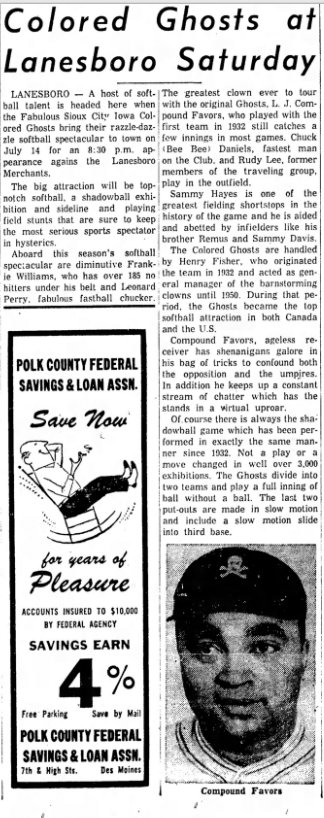
Pitching style and substance
Starting in the early 1930s, the team began concentrating on the comedy routines and pranks for their games. One of the Ghosts’ favorite routines was shadowball. A Carroll Daily Times Herald article from July 12, 1962, described the spectacle.
“Of course, there is always the shadowball game, which has been performed in exactly the same manner since 1932. Not a play or a move changed in well over 3,000 exhibitions. The Ghosts divide into two teams and play a full inning of ball without a ball. The last two put-outs are made in slow motion and include a slow-motion slide into third base.”
The Ghosts were true showmen, sometimes pitching melons instead of softballs. They also rode bicycles in the outfield. Showcasing these stunts didn’t mean the Ghosts’ record suffered, though. They team often played the best amateur teams cities had, including farm leagues, all-star teams and state champions. The Ghosts won more than 2,000 games and lost less than 100 games during a 20-year span, noted siouxcityhistory.org. The Ghosts even challenged the Harlem Globetrotters’ softball team to a game, although the game was never played.
The Ghosts toured Canada and the western United States, playing in Las Vegas, Phoenix and San Francisco. Some of the Ghosts’ games attracted huge audiences. In Vancouver, Canada, 26,000 people came to watch the game.
While the Sioux City Ghosts were celebrated on the field, things were much different when the game was over. Many of the better players tried to move into the professional leagues, but couldn’t because they were black.
“The Ghosts actually didn’t play in a league,” Aguirre added. “They toured and basically played anyone who would get on the field with them. They faced substantial racism and prejudice, and were often at the mercy of those living in the towns they visited.”
The team broke up at the beginning of World War II when many of the players entered the armed forces. The Ghosts resumed playing as a team, however, after the war. While players from other teams were added from time to time, the Ghosts always remained a mostly Sioux City team.
 Leaving a legacy
Leaving a legacy
The Ghosts included a variety of beloved players through the years, including Richard “Sitting Bull” Fields, “Oatie” Fields, Riley Fields, Willie Lee, Glenn Smith, Lawrence Freeman, Floyd “Fuji” Fulton, Benny Hamilton, Jamie Hicks, Clarence “Darby” Hicks, Rudy Lee, Major Ray, Fred Tolson, Robert Green, Vivian Johnson, Clayton Johnson, Bob Metcalf, Sam Davis, J.C. “Cool Papa” Johnson, Valse “Mickey Mouse” Metcalf, George “Smokey Joe” Murphy, Harold “Speedy” Williams, Reginald “Cricket” Williams, Frank “Papa Be Kind” Williams, Sam Hays, Benny Hamilton, Les “Spook” Wilkinson and L.J. “Bambino” Favors.
“Favors was quite the ball player,” Aguirre said. “He joined the Ghosts in 1934 and also played for the Colored House of David, Sioux City’s colored baseball team. He was inducted into the Iowa Men’s State Softball Hall of Fame in 1975.”
Favors was mentioned in the article “Colored Ghosts at Lanesboro Saturday,” which ran in the July 12, 1962, issue of the Carroll Daily Times Herald.
“The greatest clown ever to tour with the original Ghosts is L.J. Compound Favors, who played with the first team in 1932 and still catches a few innings in most games,” noted the article, which promoted the “razzle-dazzle softball spectacular” slated for July 14 at 8:30 p.m. against the Lanesboro Merchants. “Favors, an ageless receiver, has shenanigans galore in his bag of tricks to confound both the opposition and the umpires. In addition, he keeps up a constant stream of chatter, which has the stands in a virtual uproar.”
While Favors and his teammates thrilled audiences into the early 1960s in small Iowa towns like Lanesboro, Lake Park, Hinton and other communities, times were changing. One big milestone came in 1947, when Jackie Robinson broke the color barrier by becoming the first black athlete to play Major League Baseball (MLB) after joining the Brooklyn Dodgers.
With the integration of MLB, all-black teams like the Sioux City Ghosts became less common. While the last Sioux City Ghosts player, Franklin Williams, died in 2007, the team’s legacy lives on, thanks to the Sioux City Museum and the Smithsonian Institution in Washington, D.C., which preserves some of the Sioux City Ghosts’ memorabilia.
“The Ghosts helped put Sioux City on the map and acted as ambassadors of Iowa across the nation and internationally,” Aguirre said.
Want more?
I invite you to read more of my blog posts if you value intriguing Iowa stories and history, along with Iowa food, agriculture updates, recipes and tips to make you a better communicator.
If you’re hungry for more stories of Iowa history, check out my top-selling “Culinary History of Iowa: Sweet Corn, Pork Tenderloins, Maid-Rites and More” book from The History Press. Also take a look at my other books, including “Iowa Agriculture: A History of Farming, Family and Food” from The History Press, “Dallas County” and “Calhoun County” book from Arcadia Publishing. All are filled with vintage photos and compelling stories that showcase the history of small-town and rural Iowa. Click here to order your signed copies today! Iowa postcards are available in my online store, too.
If you like what you see and want to be notified when I post new stories, be sure to click on the “subscribe to blog updates/newsletter” button at the top of this page, or click here. Feel free to share this with friends and colleagues who might be interested, too.
Also, if you or someone you know could use my writing services (I’m not only Iowa’s storyteller, but a professionally-trained journalist with 20 years of experience), let’s talk. I work with businesses and organizations within Iowa and across the country to unleash the power of great storytelling to define their brand and connect with their audience through clear, compelling blog posts, articles, news releases, feature stories, newsletter articles, social media, video scripts, and photography. Learn more at www.darcymaulsby.com, or e-mail me at yettergirl@yahoo.com.
Let’s stay in touch. I’m at darcy@darcymaulsby.com, and yettergirl@yahoo.com.
Talk to you soon!

Shattering Silence: Farmer Helped Slave Find Freedom and Racial Equality in Iowa
How much is your freedom worth? In 1834, it was worth $550 for a slave named Ralph Montgomery, whose tumultuous story would involve hope for freedom, dashed dreams, bounty hunters, tremendous risk and a groundbreaking court decision that continues to inspire Iowans to shatter the silence on the volatile issue of racial inequality.
“He was born into slavery, a piece of property allowed only to serve others,” noted the article “Iowa Supreme Court’s First Case Freed a Slave,” which ran in 2015 in The Courier newspaper in Waterloo. “Even his name belonged to someone else.”
He came into the world as Rafe Nelson, probably in about 1795. But early on Nelson became Ralph Montgomery, named for his slave master in Virginia. After being taken to Kentucky by his owner and namesake, Ralph was described as “quite a chunk of a field hand” in his 20s. Despite that fact — or perhaps because of it—Ralph Montgomery, the slave master, sold his slave to a brother.
The new owner, William Montgomery, then sold Ralph in 1830 to a son, Jordan Montgomery. Newspaper accounts of the era described Jordan Montgomery as “kind and indulgent.”
Jordan Montgomery subsequently took Ralph to Palmyra, Mo., located northwest of Hannibal, the famed Mississippi River town. Ralph served his owner for about two years in Palmyra, which was roughly 60 miles south of the Iowa border.
“Here [at Palmyra], Ralph met a white man named Ellis Schofield, who had just returned from a trip to the Upper Mississippi region’s lead mining regions. He told such glowing tales of boundless wealth to be acquired there that Ralph became “seized with a burning desire to go and work out his own salvation,” according to the Janesville Gazette in Wisconsin.
Seeking freedom in Iowa
Jordan Montgomery and Ralph worked out a written agreement sometime around 1834 or 1835, where Ralph committed to pay $550, with interest, for his freedom. He traveled northward, “strong of purpose and light of heart,” according to a story in the Janesville Gazette in 1870.
Ralph went to work mining lead in Dubuque in the Iowa Territory. After five years, however, he hadn’t been able to repay the debt. The problem was the high cost of living. Ralph apparently struggled simply to pay room and board, according to historian Dorothy Schwieder, author of the book Iowa: The Middle Land.
At the same time, Jordan Montgomery experienced financial difficulties, struggling to repay a $4,000 bank loan. When two men from Virginia offered to return Ralph to his cash-strapped master in Missouri for a fee of $100. Jordan Montgomery wasn’t inclined to write off Ralph as bad debt, so he accepted the bounty hunters’ offer.
Shattered dreams
The Virginians swore an affidavit in front of a justice of the peace that Ralph was a fugitive. Court official ordered the local sheriff to assist the bounty hunters. The group found Ralph at his mineral claim, put him in handcuffs and loaded him onto a wagon.
Alexander Butterworth, variously described as a farmer, businessman, concerned eyewitness and noble-hearted Irishman in the Dubuque area, was plowing a nearby field and saw the kidnapping. Butterworth dashed to Dubuque to notify Thomas Wilson, an associate judge on the newly formed Supreme Court of the Territory of Iowa.
Let’s take it to court
Judge Wilson ordered the sheriff to follow the bounty hunters who had seized Ralph and return bring Ralph to Dubuque. Armed with a writ of habeas corpus and accompanied by the sheriff, Butterworth galloped to the rescue, noted historical accounts.
The Virginians had managed to get Ralph to Bellevue, Iowa, along the Mississippi River to board a riverboat that would transport him back to Missouri. Butterworth and the sheriff reached the dock just in time. They ordered the riverboat captain to return Ralph to Dubuque for a hearing before Judge Wilson.
Ralph’s case would turn out to be the first decided by the Territory of Iowa’s Supreme Court, which had been established in 1838 in Burlington. The court’s inaugural case was titled “In the matter if Ralph (a colored man), on Habeas Corpus.”
The legal question was whether Jordan Montgomery had a legitimate claim to demand Ralph’s return. Jordan Montgomery’s lawyers argued when Ralph relocated to the Iowa Territory, slavery was not specifically prohibited in Iowa under the so-called Missouri Compromise of 1820, since a local legislature had not taken additional action to ban it. Jordan Montgomery’s lawyers also claimed Ralph was a fugitive slave, since he had failed to fulfill his contract and should be returned to Missouri under conditions of the federal Fugitive Slave Act.
Ralph Montgomery’s attorney, David Rorer, argued that Ralph became a free man when, by consent of his master, Ralph moved to Iowa. Rorer, and rising star in the Iowa Territory, claimed that his client was neither a slave nor a fugitive, in part because he entered a contract “which presupposes a state of freedom.” Rorer also cited an English case in which it was ruled that a slave having lived in a free country could not be taken to another land that would again lead him into slavery. According to Rorer, the only obligation Ralph owed was to raise the $550 for his former owner in Missouri.
Rorer also cited Chapter 23 of the Book of Deuteronomy in the Bible, which says, in part: “Thou shalt not deliver unto his master the servant which is escaped from his master unto thee: He shall dwell with thee, even among you.”
Ruling delivered on Independence Day 1839
The Iowa Supreme Court conceded Ralph Montgomery should repay Jordan Montgomery — with one key stipulation. “It is a debt which he ought to pay, but for the non-payment of which no man in this territory can be reduced to slavery,” wrote Charles Mason, the first chief justice of the Iowa Supreme Court.
Mason concluded Ralph Montgomery “should be discharged from all custody and constraint, and be permitted to go free while he remains under the protection of our laws.” The Iowa Supreme Court declared Ralph Montgomery a free man on Independence Day, July 4, 1839.
In their opinion, the court justices wrote, “When, in seeking to accomplish his object, (the claimant) illegally restrains a human being of his liberty, it is proper that the laws, which should extend equal protection to men of all colors and conditions, should” intervene.
The unanimous ruling established the tradition in Iowa’s courts of ensuring the rights and liberties of all the people of the state. Years later, the state legislature adopted Iowa’s motto: “Our liberties we prize and our rights we will maintain,” which stands as a permanent reminder that the freedoms in this state are freedoms for all.

What happened to Ralph?
Ralph Montgomery remained in Iowa for the rest of his life. According to the State Historical Society of Iowa, he showed up one day to work in Judge Wilson’s garden in 1840 (one year after the Iowa Supreme Court ruling in his favor). “I ain’t paying you for what you done for me,” Ralph said. “But I want to work for you one day every spring to show you that I never forget.”
Ralph Montgomery stayed in Dubuque the rest of his life, a free man. While not much is known about how he lived the remainder of his life, we do know he continued to mine lead and was a familiar figure around town. While the Dubuque Times in 1870 credited Ralph Montgomery with finding several valuable lodes, he eventually fell in hard times, either through being swindled or by gambling, according to conflicting accounts. During his later years, he lived in the county poor house, according to the Dubuque Times. He succumbed to smallpox, a disease he contracted while nursing a sick patient, during his time in Dubuque’s pest house. He died on July 23, 1870.
(A pest house, short for pestilence house, was a quarantine facility typically found throughout American communities in the late 1800s. Before the development of hospitals, people afflicted with communicable diseases such as tuberculosis, cholera, smallpox or typhus were placed in pest houses.)
Ralph was buried in the city cemetery which became in Jackson Park in later years, according to Encyclopedia Dubuque. When that cemetery was closed, Ralph’s remains were among those moved to Linwood Cemetery, where they were buried in a mass grave.
Ralph Montgomery’s case offered much different outcome than Dred Scott case
Eighteen years later, the lessons of Ralph Montgomery’s case seemed to be forgotten when Missouri slave Dred Scott pleaded his case for freedom in court. On March 6, 1857, the U.S. Supreme Court handed down its decision on Sanford v. Dred Scott, a case that intensified national divisions over the issue of slavery.
In 1834, Dred Scott, a slave, had been taken to Illinois, a free state, and then to the Wisconsin Territory, an area where the Missouri Compromise of 1820 prohibited slavery. Scott lived in Wisconsin with his master, Dr. John Emerson, for several years before returning to Missouri, a slave state. In 1846, after Emerson died, Scott sued his master’s widow for his freedom on the grounds that he had lived as a resident of a free state and territory. He won his suit in a lower court, but the Missouri Supreme Court reversed the decision.

Dred Scott
Scott appealed the decision. A federal court decided to hear the case on the basis of the diversity of state citizenship represented. After a federal district court decided against Scott, the case came on appeal to the U.S. Supreme Court, which was divided along slavery and antislavery lines; although the Southern justices had a majority.
During the trial, the antislavery justices used the case to defend the constitutionality of the Missouri Compromise, which had been repealed by the Kansas-Nebraska Act of 1854. The Southern majority responded by ruling on March 6, 1857, that the Missouri Compromise was unconstitutional and that Congress had no power to prohibit slavery in the territories. Three of the Southern justices also held that African Americans who were slaves or whose ancestors were slaves were not entitled to the rights of a federal citizen, and therefore had no standing in court.
These rulings all confirmed that, in the view of the nation’s highest court, under no condition did Dred Scott have the legal right to request his freedom. The Supreme Court’s verdict further inflamed the irrepressible differences in America over the issue of slavery, which in 1861 erupted with the outbreak of the American Civil War.
Shattering Silence
It would take the Civil War, the passage of the 13th Amendment to abolish slavery and the civil rights’ movement of the mid-20th century to help create a more just America for everyone, regardless of race. The battle is not yet over, as evidenced by the Black Lives Matter movement, police brutality (in tragic cases such as the death of George Floyd in Minneapolis in late May 2020) and the resulting civil unrest that has swept America.

Shattering Silence in Des Moines near Iowa Supreme Court (photo from Des Moines Public Art Foundation)
Even as racial-charged protests turned into riots in downtown Des Moines during the weekend of May 30-31, a 30-foot sculpture near the Iowa Supreme Court pointed to the hope that has endured in Iowa from the beginning.
“Shattering Silence,” which features a ring made of limestone quarried in Dubuque, was designed by artist James Ellwanger and installed in 2009 on the 170th anniversary of the Iowa Territory Supreme Court’s landmark decision in the Ralph Montgomery case. (Photo credit for the winter image of Shattering Silence that I used with this post goes to Jason Mrachnia.)
The stunning sculpture stands at the top of the hill overlooking the Des Moines skyline. The Iowa Art Council has called the piece a commemoration of “those moments when Iowa has been at the forefront of breaking the silence of inequality and commemorates those Iowans who refused to stand by silently when they saw injustice.”
Former slave who made history in Iowa leaves powerful legacy
Back in Dubuque, local residents raised money in recent years to install a tombstone to honor Ralph Montgomery. On October 1, 2016, community leaders unveiled a monument to Ralph in the Linwood Cemetery to highlight Iowa’s ongoing role in shattering the silence on the issue of racial inequality.
“We are gathered today to honor a man who has brought such honor to this state by helping us discover not only who we were at that time, but who we would hope to become today,” said Mark Cady, former chief justice of the Iowa Supreme Court who passed away in November 2019. “Ralph Montgomery suffered through the indignity of slavery to rise and stand against it and help forge a great meaning …of our collective belief in equality, both then and now.”
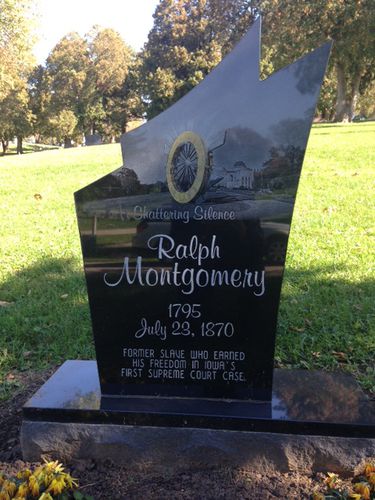
Want more?
I invite you to read more of my blog posts if you value intriguing Iowa stories and history, along with Iowa food, agriculture updates, recipes and tips to make you a better communicator.
If you’re hungry for more stories of Iowa history, check out my top-selling “Culinary History of Iowa: Sweet Corn, Pork Tenderloins, Maid-Rites and More” book from The History Press. Also take a look at my other books, including “Iowa Agriculture: A History of Farming, Family and Food” from The History Press, “Dallas County” and “Calhoun County” book from Arcadia Publishing. All are filled with vintage photos and compelling stories that showcase the history of small-town and rural Iowa. Click here to order your signed copies today! Iowa postcards are available in my online store, too.
If you like what you see and want to be notified when I post new stories, be sure to click on the “subscribe to blog updates/newsletter” button at the top of this page, or click here. Feel free to share this with friends and colleagues who might be interested, too.
Also, if you or someone you know could use my writing services (I’m not only Iowa’s storyteller, but a professionally-trained journalist with 20 years of experience), let’s talk. I work with businesses and organizations within Iowa and across the country to unleash the power of great storytelling to define their brand and connect with their audience through clear, compelling blog posts, articles, news releases, feature stories, newsletter articles, social media, video scripts, and photography. Learn more at www.darcymaulsby.com, or e-mail me at yettergirl@yahoo.com.
Let’s stay in touch. I’m at darcy@darcymaulsby.com, and yettergirl@yahoo.com.
Talk to you soon!
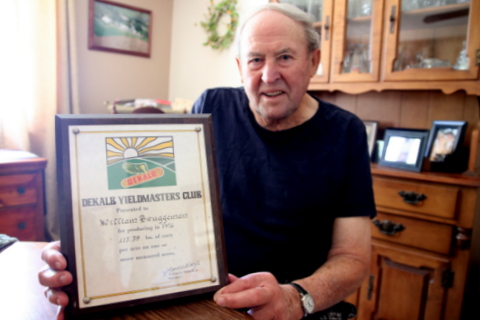
Memories of Carroll County, Iowa, Century Farm Endure
Among the most remarkable parts of rural Iowa are the thousands of families who have owned the same land for 100 years. I’ve had the chance to interview hundreds of Iowa families who own Century Farms. Some of these folks, like Bill Bruggeman, share the kinds of stories you never forget.
After Bill passed away this week (read his touching obituary here), I felt that sharing his story would be a fitting tribute to a dedicated, kind, hard-working Iowa farmer I respect greatly Here’s his story, which I wrote in 2017 for Farm News:
While all the buildings that once graced the Bruggeman family’s Carroll County Century Farm between Lidderdale and Lake City are gone, the memories live on.
“The times keep changing,” said Bill Bruggeman, 85, who lives with his wife, Doris, on a farm a few miles northeast of his family’s Sheridan Township Century Farm. “This spring I saw a farmer on RFD TV who could plant 2,500 acres a day. This country is going big.”
It’s a big switch from the 120-acre Carroll County farm that Bruggeman’s grandfather, John Bruggeman, purchased in 1903. John and his wife, Emma, had farmed near Johnson, Nebraska, before deciding their farming prospects were brighter back in Iowa.
While Bruggeman didn’t grow up on the Century Farm where his grandparents lived, he has fond memories of the farmstead, which once boasted a large farmhouse and barn. “When I was a little kid I’d go across the fields on Saturday mornings to get Grandma Emma’s fresh-baked cinnamon rolls,” he recalled.
Good food was perk of farm life, which was often filled with long days of hard work and few luxuries. “We didn’t get electricity on the farm until the 1940s and didn’t get running water until the 1950s,” Bruggeman said.
Horsepower sometimes came from the family’s Farmall tractor, but it also came in the form of May and Babe. “I loved that team,” said Bruggeman, whose family used the horses to plant corn, pull the manure spreader and haul hay. “They didn’t run away.”
Those were the days when 12 neighborhood families worked together in a threshing ring, a tradition that lasted until the mid-1950s. While Bruggeman’s father, Carl, and the other men worked in the field, Bruggeman’s mother, Marie, prepared fried chicken, roast beef, mashed potatoes, fruit pies, cream pies and more to serve the hungry men at noon.
“Around 5 p.m. you’d haul the last load of the day,” said Bruggeman, who noted that the wives provided the threshing crew with snacks around 3 p.m. “The men were usually served supper, too.”
The day’s work wasn’t done, however, since each farmer had chores to do at home. “Back then, many farms had about 20 beef cows, some dairy cows and about 10 sows,” Bruggeman said.
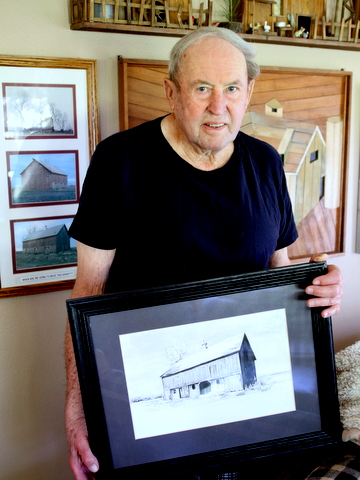
While the demands of farm work limited trips to town, there was fun to be had when it to was time to buy groceries. Bruggeman enjoyed the outdoor movies shown in Lidderdale in the summer months, back when the town had three grocery stories and about as many gas stations. “Dad would give me a nickel so I could get a pop or popcorn,” said Bruggeman, who recalled how cars were lined up on both sides of the town’s busy business district.
Money was hard to come by in those days, and crop yields were nowhere close to what farmers produce today. “When I was a kid, 60 bushels per acre of corn was a really good yield,” said Bill Bruggeman, who started farming full-time in 1955 after completing his military service. As improved corn hybrids become available, Bruggeman won the DEKALB Yieldmasters Club award in 1976 for producing 113.39 bushels of corn per acre.
While much has changed in agriculture since the Bruggemans were raising their four children (including Sheila, Brenda, Cathy and Brett) on the farm, the family is proud to honor the legacy of their Century Farm, which is now owned by Brett Bruggeman.
“It’s wonderful to have a Century Farm,” said Bruggeman, who retired from farming three years ago. “We’re lucky to have one.”
Bruggeman Carroll County Century Farm
• Established: 1903
• Township: Sheridan
• Acres: 120
• Century Farm Award given in 2016
• 4th generation farm
Want more?
Thanks for stopping by. I invite you to read more of my blog posts if you value intriguing Iowa stories and history, along with Iowa food, agriculture updates, recipes and tips to make you a better
If you’re hungry for more stories of Iowa history, check out my top-selling “Culinary History of Iowa: Sweet Corn, Pork Tenderloins, Maid-Rites and More” book from The History Press. Also take a look at my latest book, “Dallas County,” and my “Calhoun County” book from Arcadia Publishing. Both are filled with vintage photos and compelling stories that showcase he history of small-town and rural Iowa. Order your signed copies today! Iowa postcards are available in my online store, too.
If you like what you see and want to be notified when I post new stories, be sure to click on the “subscribe to blog updates/newsletter” button at the top of this page, or click here. Feel free to share this with friends and colleagues who might be interested, too.
Also, if you or someone you know could use my writing services (I’m not only Iowa’s storyteller, but a professionally-trained journalist with 20 years of experience), let’s talk. I work with businesses and organizations within Iowa and across the country to unleash the power of great storytelling to define their brand and connect with their audience through clear, compelling blog posts, articles, news releases, feature stories, newsletter articles, social media, video scripts, and photography. Learn more at www.darcymaulsby.com, or e-mail me at yettergirl@yahoo.com.
Let’s stay in touch. I’m at darcy@darcymaulsby.com, and yettergirl@yahoo.com.
Talk to you soon!
Darcy
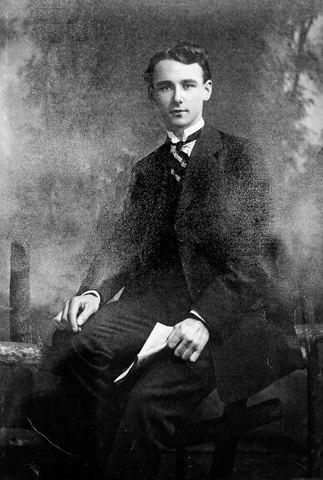
Independence, Iowa’s Connection to the Titanic and Carpathia
It’s amazing how many Iowans have ties to the Titanic, even all these years after the great ship sank. During a program at the Independence Public Library in June 2019, a lady named Ann Gitsch from Independence approached me following the program. As soon as she mentioned she had a relative on the Carpathia who helped rescue Titanic survivors, she had my total attention.
Ann mentioned that her family was from Northumberland in northeast England, and her grandmother, Wynanda Purvis was an aunt to Robbie Purvis, who was a steward on the Carpathia. Robbie Purvis was working on the Carpathia when the steamship rescued passengers from the Titanic during the early morning hours of April 15, 1912.
As Gitsch told me about Purvis, she handed me a copy of an unnamed publication with an article titled “Alnwick Schoolboy’s Experience.” (Alnwick is a town in Northumberland, England.)
The following article was taken from a 1912 letter Purvis wrote to his parents, including Mr. R. Purvis of Battery Hostel, Alnmouth, in northern England, following the Titanic disaster. The news article promised to be “of special interest to those were his [Purvis’s] schoolmates at the Duke’s School:”
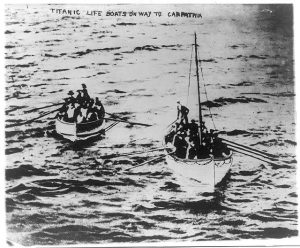
Survivors from the Titanic row towards the Carpathia
We have reached Gibraltar at last after the most eventful voyage I have ever experienced. I suppose you have seen the papers about the Carpathia getting the Marconi message which was sent from the Titanic before she went down. The captain got the message at 12:15. All the crew were in bed, so he sent down the chief steward to call all the stewards and stewardesses. At first the men would not get up. They thought it was just some boat drill they were wanted for, but they got up quick enough when they heard exactly what had happened—that the Titanic was sinking, and that the Carpathia had turned around and was going as hard as she could to assist her.
We got all together in the dining saloon, and the chief steward told us exactly what to do. Some were sent to carry blankets, other to lay up tables and make coffee, and some to man the boats in case they should be lowered.
I have an oar in Number 12 boat. We had the ship ready to receive 2,800 passengers by half past two. We got the first boat [from the Titanic] at 4 in the morning full of women and children. There were all nearly mad with cold. There was only two men in the boat—one a sailor who had gone mad. We hauled them all up the ship’s side with ropes tied around them and the children in canvas bags. We picked the last boat up at ? o’clock [newsprint here was illegible] and took altogether 780 persons safely on board. [Purvis’ count wasn’t quite accurate. Later accounts reported that Carpathia rescued 705 survivors from the Titanic, and rescue efforts were completed by 8:30 a.m. on Monday, April 15, 1912.]
We took eight dead bodies out of the boat and buried them at sea. We did not take any dead bodies into New York.
We came quite close to the iceberg which the Titanic struck. It was about a mile long and 100 feet high. There were plenty of bergs scattered about, but none so big as this one. We had to come right through amongst them in the dark looking for lifeboats. We sailed exactly over the spot where the Titanic went down, just a dark patch on the water with deck chairs and cushions and dead bodies (some babies) all floating about amongst the wreckage. It was a heart-rending sight.
When we got to New York, we had about 200 boats down to meet us, two American battleships amongst them. Men were down taking moving pictures of the ship docking, and of the Titanic’s passengers leaving her [the Carpathia]. Several of the passengers we brought back wanted to give us dinner, but the captain would not let us leave the ship, as we were sailing as soon as we could get coal in.
I am sending you an account of the wreck written by myself. I must now draw to a close, as I have no time for more now. I remain, etc., Robbie

Carpathia rescue ship
Iceberg “glistening in the morning sun like a tombstone”
Printed in this same newspaper, beneath Purvis’s letter, was a small section called “Notes from Carpathia,” which contained more details that Purvis jotted down:
“The Carpathia reached the scene of the disaster at 4 a.m. Everything was still. Lifeboats were scattered about the horizon, crowded with half-frozen, lamenting women and children, whose dear ones had been so ruthlessly snatched from them. A giant iceberg loomed up, glistening in the morning sun like a tombstone. A huge dark patch on the icy water with many bodies mingled with wreckage, marked the spot where the ill-fated Titanic went down.
Bodies floated about among the wreckage. Some were those of women and children, others of weather-beaten sailors, whose horny fingers had grasped a floating spar till God had relieved them of their sufferings. The Carpathia sailed on around the scene of the disaster, the dark, icy water lapping against her iron sides, as if mocking her for being too late.”
Want more?
Thanks for stopping by. I invite you to read more of my blog posts if you value intriguing Iowa stories and history, along with Iowa food, agriculture updates, recipes and tips to make you a better communicator. My new non-fiction book, “Iowa’s Lost History on the Titanic,” will be coming out in 2019. In the meantime, click here to get a taste of the fascinating stories you’ll find in this book.
If you’re hungry for more stories of Iowa history, check out my top-selling “Culinary History of Iowa: Sweet Corn, Pork Tenderloins, Maid-Rites and More” book from The History Press. Also take a look at my latest book, “Dallas County,” and my Calhoun County” book from Arcadia Publishing. Both are filled with vintage photos and compelling stories that showcase he history of small-town and rural Iowa. Order your signed copies today! Iowa postcards are available in my online store, too.
If you like what you see and want to be notified when I post new stories, be sure to click on the “subscribe to blog updates/newsletter” button at the top of this page, or click here. Feel free to share this with friends and colleagues who might be interested, too.
Also, if you or someone you know could use my writing services (I’m not only Iowa’s storyteller, but a professionally-trained journalist with 20 years of experience), let’s talk. I work with businesses and organizations within Iowa and across the country to unleash the power of great storytelling to define their brand and connect with their audience through clear, compelling blog posts, articles, news releases, feature stories, newsletter articles, social media, video scripts, and photography. Learn more at www.darcymaulsby.com, or e-mail me at yettergirl@yahoo.com.
Let’s stay in touch. I’m at darcy@darcymaulsby.com, and yettergirl@yahoo.com.
Talk to you soon!
Darcy
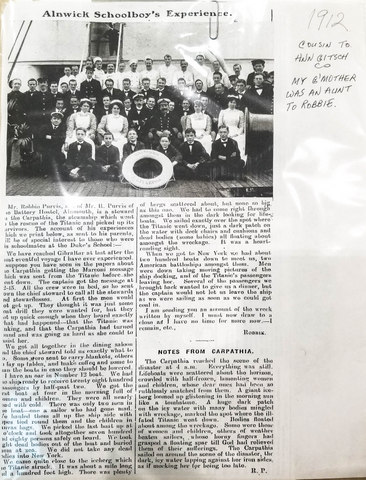
1912 news clipping sharing Robbie Purvis’ Titanic story

What’s the Scoop? Expanded Wells’ Ice Cream Parlor Offers a Taste of Iowa
Love ice cream? Think you can handle something as outrageous as the Monster Peanut Butter Cup Sundae? Then you MUST visit Le Mars, Iowa, soon. Everything is bigger and better at the revamped Wells Visitors Center and Ice Cream Parlor in downtown Le Mars, from the extreme milkshakes and sundaes (Savannah Peach, anyone?) to the spacious parlor itself, where you
can enjoy their sweet treats in the retro-styled dining area or new movie theater upstairs.
“This is a one-of-a-kind experience,” said Adam Baumgartner, vice president of retail sales for Wells Enterprises, Inc., whom I visited with during a recent media day at the ice cream parlor. “Beyond the Iowa State Fair, we want to make this the single-biggest tourist attraction in Iowa.”
More than 200,000 people have visited the parlor each year since it opened in 2011. “Our goal is to more than double that,” said Baumgartner, who noted that the remodeled parlor/visitor center blends education, entertainment and unique experiences for guests of all ages.
In the past year, Wells has invested $3 million in upgrades and expansions for the rebranded facility, which is housed in a historic 1917 building on Central Avenue. Highlights include:
• An interactive “farm to spoon” look at ice cream, from the dairy farm to the grocery store.
• An expanded ice cream menu with more novelties, extreme shakes and desserts, including the Lemon Meringue Shake, Monster Peanut Butter Cup Sundae, Molten Chocolate Lava Shake and more.
• An ice cream cone-shaped display where guests can take fun selfies and share them through text messages and social media.
• A rooftop seating area with views of historic downtown Le Mars.
• Handicap accessibility throughout the building.
• Event center space that can hold up to 200 guests. The space can be rented for parties, meetings and other gatherings.
• The Wells Family Theater, where a short film plays multiple times each hour to tell the story of how Wells and Le Mars came together.
• An engaging Heritage Wall filled with vintage pictures and more to document the unique history of Wells.
• An updated gift shop filled with ice cream-inspired items.
• More space to house all these attractions. The remodeled visitor center/ice cream parlor includes 19,000 square feet, up from 12,000 square feet.

Guests can visit the revamped Wells Visitors Center and Ice Cream Parlor in downtown Le Mars. Members of the Wells team have been welcoming the media and the public to the remodeled facility. Shown here (left to right) are Shannon Rodenburg, Visitor Center marketing and tourism manager; Brenda Phelan, associate manager of food operations: Jean Ann Weiland, associate manager of team operations; Adam Baumgartner, vice president of retail sales; and Brett Susemihl, manager of the Visitor Center and Ice Cream Parlor.
Above all, the parlor reflects Wells’ mission to bring joy to everyday life because of the love of ice cream. “We’re building on a unique family legacy,” Baumgartner said. “We want to put a smile on the face of ice cream lovers for years to come.”
Discover the history of the sweetest place on Earth
All this drives economic development in rural Iowa. Wells employs nearly 3,000 people and produces 150 million gallons of ice cream each year.
“Wells gets all of its fresh dairy from within 75 miles of our production facilities in Le Mars,” said Shannon Rodenburg, marketing and tourism manager for the Wells Visitor Center and Ice Cream Parlor. “Wells collects and processes more than 20 tankers of milk each day, 365 days a year.”
It all began on Oct. 24, 1913, when Fred H. Wells signed a contract with Ray Bowers, a dairy farmer in Le Mars, for “one grey horse, one milk wagon, two barn cans, three 20-quart jars, 60 half-pint jars and the good will of the milk business he has in the city of Le Mars, Iowa,” all for $250. (That’s roughly $6,400 today.) The original contract granted Wells the milk distribution route and guaranteed a source of raw milk from Bower’s herd of 15 cows.
Around 1925, Wells and his sons began manufacturing ice cream in Le Mars. As the popularity of their ice cream grew, they quickly branched out and began distributing their frozen confections in Remsen and Alton, Iowa, the following year. By 1927, Wells and his brother, Harry C. Wells, began a partnership to distribute ice cream in Sioux City.
A big change occurred, however, in 1928, when Fairmont Ice Cream purchased the ice cream distribution system in Sioux City from the Wells brothers, along with the right to use the Wells name. That could have been the end of the ice cream business for Wells, but it wasn’t.
Seven years later, in 1935, the Wells brothers decided to again sell ice cream in Sioux City. No longer able to use the name “Wells,” the brothers decided to run a “Name That Ice Cream” contest in the Sioux City Journal. A Sioux City man, George Vanden Brink, won the $25 cash prize for submitting the winning entry, “Blue Bunny,” after noticing how much his son enjoyed the blue bunnies in a department store window at Easter time. Vanden Brink, who was an illustrator by trade, also created the first Blue Bunny logo, which appeared on Blue Bunny packaging for nearly 70 years.

The revamped Wells Visitors Center and Ice Cream Parlor offers an expanded ice cream menu with more novelties, extreme shakes and desserts, including the Monster Peanut Butter Cup Sundae.
What started as Blue Bunny Ice Cream® has grown to include multiple brands and licensed products today. The company makes nearly 1,000 different products, Baumgartner said.
In fact, there is more ice cream made in Le Mars than in any one location on Earth, making Le Mars the Ice Cream Capital of the World—a title the community has held since Iowa’s state legislature made it official in 1994.
Bringing the ice cream story to life
From a single delivery wagon to the world’s largest family-owned and managed ice cream producer, Wells’ 100+ years in the industry is a pretty sweet story. The company has set its sights on becoming the leading ice cream manufacturer in the nation.
Giving Wells’ ice cream parlor/event center a facelift is part of a bigger goal to make Le Mars a destination, Baumgartner said. “Iowa has a lot of great things to offer. This is a place you have to see. You’ll love it.”
Want more?
Thanks for stopping by. I invite you to read more of my blog posts if you value intriguing Iowa stories and history, along with Iowa food, agriculture updates, recipes and tips to make you a better communicator.
If you’re hungry for more stories of Iowa history, including more stories of Wells and Blue Bunny, check out my top-selling “Culinary History of Iowa: Sweet Corn, Pork Tenderloins, Maid-Rites and More” book from The History Press. Also take a look at my latest book, “Dallas County,” and my Calhoun County” book from Arcadia Publishing. Both are filled with vintage photos and compelling stories that showcase he history of small-town and rural Iowa. Order your signed copies today! Iowa postcards are available in my online store, too.
If you like what you see and want to be notified when I post new stories, be sure to click on the “subscribe to blog updates/newsletter” button at the top of this page, or click here. Feel free to share this with friends and colleagues who might be interested, too.
Also, if you or someone you know could use my writing services (I’m not only Iowa’s storyteller, but a professionally-trained journalist with 20 years of experience), let’s talk. I work with businesses and organizations within Iowa and across the country to unleash the power of great storytelling to define their brand and connect with their audience through clear, compelling blog posts, articles, news releases, feature stories, newsletter articles, social media, video scripts, and photography. Learn more at www.darcymaulsby.com, or e-mail me at yettergirl@yahoo.com.
Let’s stay in touch. I’m at darcy@darcymaulsby.com, and yettergirl@yahoo.com.
Talk to you soon!
Darcy

In the past year, Wells has invested $3 million in upgrades and expansions for the Wells Visitors Center and Ice Cream Parlor in downtown Le Mars. Guests can enjoy their ice cream in the retro-styled dining area or new movie theater upstairs.
@Copyright 2019 Darcy Maulsby & Co. Blog posts may only be reprinted with permission from Darcy Maulsby.

Senator Grassley on Farming: Any Society is Only Nine Meals Away From a Revolution
When people ask about my latest book project and I tell them about Iowa’s Ag History, I get two reactions: either a blank stare, or “Oh cool!” When I reached out to Iowa Senator Charles Grassley, a farmer, to share a few comments for the book, I received more than an enthusiastic response.
I got an incredible interview from a senator who was willing to offer a significant portion of his time to share his insights into the importance of history, agriculture and rural Iowa’s role in the modern global economy. Read on to see why Sen. Grassley says, “I like to remind policymakers that any society is only nine meals away from a revolution.”
When did your family start farming in Iowa?
I am the second generation farmer in my family, following in the footsteps of my father Louis Grassley. His dad emigrated from Germany and died when my dad was just seven years old. At around age 18, my dad started working as a hired hand for the Heitland family on a farm in Hardin County. A few years later, he rented some land near New Hartford in Butler County. In 1927, he and my mother Ruth purchased their own parcel of land.
After graduating from high school, I worked in factories, attended college and farmed with my dad. In 1958, while running for the Iowa legislature and working towards my doctorate at the University of Iowa, I started farming my own piece of the family farm. When my dad passed away in 1960, I rented his 80 acres and about five years later, purchased 120 acres on my own.
When I started out, I grew a bit of everything like most farmers at the time. I grew corn, soybeans, oats and alfalfa and raised sheep, cattle and hogs. My son Robin Grassley, a third-generation farmer, and I continue farming 750 acres together. He rents and owns other farmland along with my grandson Pat Grassley, who is a fourth-generation family farmer.
Barbara and I raised our five children together on our farm near New Hartford, and we enjoy passing on our agrarian heritage and celebrate family gatherings here with our grandchildren and great-grandchildren.
In politics as in farming, a solid understanding of the past is vital to understand current issues. From your unique viewpoint as a senator and a farmer, what’s your take about why it’s important to be well-versed in history–and what are the perils of not knowing history?
As a lifelong farmer who also has worked for six decades representing Iowans in state and federal government, I wear my rural roots as a badge of honor and believe it’s important for farmers to have a seat at the policy-making tables. Farmers take the long view of things, and maybe that’s why they don’t forget important lessons from history.
Only two percent of the American population shoulders the responsibility for growing enough food to feed the U.S. population. Our agrarian-based heritage has experienced rapid transformation in the last generation. Fewer Americans, even in Iowa, have a direct link to living or working on a farm. And most likely due to the affordable abundance of food, not enough people appreciate that food security is directly tied to national security. Food security extends beyond national sovereignty. American agriculture – and the farmers, workers and businesses along the supply chain – anchors the U.S. economy and increasingly strengthens U.S. energy independence, as well.
From a historical perspective, there are two rules of thumb I use to explain how important food security is to maintain peace and prosperity in society. As Emperor of France in the early 19th century, Napoleon Bonaparte reportedly said “to be effective, an army relies on good and plentiful food.” In other words, an army marches on its stomach. Food security ensures a nation can feed its military, whose men and women in uniform are deployed to protect and defend a nation’s sovereignty, at home and abroad. I also like to remind policymakers that any society is only nine meals away from a revolution.
Political leaders who embrace the misguided notion that socialism is the answer to peace and prosperity are either grossly misinformed or willfully ignorant about the peril of leaders who promise to fix “inequality” with government control. Just look at the economic crisis in Venezuela, once one of the most prosperous nations in the Western Hemisphere. The poverty and humanitarian crisis falls squarely in the hands of the nation’s authoritarian regime and its ideologically driven policies. History teaches us that when government suppresses freedom and liberty, the people’s path towards peace and prosperity is replaced with food and medicine shortages, hyperinflation, power outages and even more economic and social inequality.
History teaches us other important lessons. Namely, how not to repeat the mistakes of the past. Don’t forget, the overly harsh tariffs in the Smoot-Hawley Tariff Act of 1932 shut down world trade, led to a worldwide economic depression and foretold a world war that killed tens of millions of people.
Another important lesson I keep in mind at the policy-making tables is the 1980s farm crisis. The loss of thousands of family farms was a heart-wrenching loss for so many families and long-time neighbors across Iowa. It stole a sense of vitality from small towns and rural communities. It arguably steered away a generation of beginning farmers from following in the footsteps of their parents and grandparents. The farm crisis invigorated my advocacy on behalf of young and beginning farmers, including my work to push for robust enforcement of anti-trust laws and oversight of mergers and competition in the agriculture industry. Previously, I’ve introduced legislation that would have amended the Packers and Stockyards Act to make it illegal for a packer to own, feed or control livestock intended for slaughter. I’ll keep my oversight hat on to protect the integrity of the marketplace so that independent producers have a fair shake at a fair price for their commodities.
I also led efforts to enact and make permanent Chapter 12 in the federal bankruptcy code. This unique chapter is designed to help farmers and ranchers who have fallen on hard times to survive bankruptcy and restructure their debts without losing their livelihood. Most recently, I secured an update to Chapter 12 to fix court rulings that undermined congressional intent. Previously, the IRS muscled its way to the front of the creditor’s line to scoop up capital gains taxes and potentially block a farmer’s reorganization plans. Farmers shouldn’t be penalized for being asset-rich and cash-poor. When they need to reorganize debts to hold on to their livelihoods, my reforms ensure they aren’t going to be slapped with a big tax bill and lose the ability to continue farming.
Another way I advocate for family farmers at the policy-making tables is my longstanding efforts to restore fiscal integrity to the farm safety net. In our free market society, farmers ought to be able to decide how large or small they want their operation to be. However, the farm safety net shouldn’t be manipulated for operations to grow at taxpayer expense. It’s very important to uphold the credibility and strengthen the public trust in the farm safety net, as well. That’s why I will continue my efforts to attach reasonable payment limits so that off-site managers, including nieces, nephews, cousins and other family members who aren’t actually contributing to the operation of the farm, are prevented from cashing in on farm payments.
In 2019, I launched my 39th consecutive year holding meetings in each of Iowa’s 99 counties. I keep in close touch with Iowans and count on this dialogue to make representative government work. I also apply the lessons of history to inform my work on making better policies and fixing laws that create unintended consequences. As chairman of the Senate Finance Committee, which has oversight and legislative jurisdiction over international trade, I’m currently working to reform a 1962 federal law that delegated authority to the executive branch. Specifically, Section 232 of the Trade Expansion Act authorizes the president to impose tariffs on selected imports if the chief executive determines those imports pose a threat to our national security.
This law was enacted with good intentions and for good reason. However, history has shown that reforms are necessary in order to give Congress a role in the process. In my view, Congress delegated too much authority to the executive branch at the expense of the people’s branch. American agriculture too often shoulders the burden of retaliatory action from our trade partners. It’s another example of why I always check the rear-view mirror to ensure the road ahead paves the way for prosperity and opportunity for family farmers and all those who earn their livelihoods and enjoy their way of life in Rural America.
What are some of the biggest changes in Iowa agriculture you’ve seen and experienced in your lifetime?
Technology and innovation have revolutionized farming as we know it. Mechanization allows an individual farmer to dramatically improve productivity and harvest bin-busting yields grown from disease-resistant seeds, for example. At the same time, farmers are able to conserve resources and save money using no-till, cover crops and precision agriculture. As a first-generation farmer, my dad used a team of horses when he started farming. Like many family farmers, the genetic code of fiscal discipline, conservation and ingrained work ethic was handed down to me from my parents’ experience carving out a living from the land. In my case, the Grassley household and farming operation was influenced by the Great Depression, to conserve resources and stretch every penny.
To this day, I carry a lifelong code of conservatism with me as a farmer and lawmaker. Although innovation – including WiFi-enabled farms and climate-controlled tractor cabs — hasn’t shortened the work day for most farmers, it’s certainly transformed productivity and changed the way we market our crops and livestock. When I started farming on my own in the 1950s, the average corn yield in Iowa was about 45 bushels/acre. Today Iowa farmers yield an average of 202 bushels/acre. This productivity helps feed and fuel a growing world population with affordable, wholesome food and renewable energy. So increased productivity has been revolutionary.
Another significant change is farmers are affected by worldwide market forces. That means a farmer in the 21st century must be able to survive not just the whims of Mother Nature, but also the winds of geo-political negotiations and foreign policy that impact exports and a farmer’s bottom line.
Ag literacy should be part of education, in my opinion, for any Iowa student. In your opinion, how does a basic understanding of agriculture benefit all Iowans, both rural and urban?
No matter what policy we may be debating in Congress, I often find the best way to sum up the debate boils down to this: Washington is an island surrounded by reality. As a farmer-lawmaker on the Senate Agriculture Committee, I bring a dirt-underneath-my-fingernails perspective to the policy-making tables. I take pride serving as a champion for rural America to advocate for our nation’s food producers and farm families. With only two percent of the population growing food for the rest of the nation, it’s more important than ever to educate consumers about where their food comes from. In fact, I often suggest that many Americans are under the mistaken impression that food grows in grocery stores, restaurants or take-out containers. I’m glad to see more and more farmers’ markets becoming a vital part of local communities. It’s good for the local economy and community vitality and fosters better awareness that food does not grow on the grocery store shelf.
With a global population expected to reach nearly 10 billion people by 2050, the importance of agriculture research and education is vital for human civilization. Iowa’s deeply rooted agrarian heritage continues to lead the way with excellent opportunities to foster ag literacy, food, plant and animal science and entrepreneurship. Iowa boasts a vibrant network of FFA organizations across the state. What’s more, Iowa’s native son Norman Borlaug paved an agricultural revolution credited with saving a billion people from starvation. The Father of the Green Revolution was awarded the Nobel Prize in 1970 and Iowa celebrates his legacy with a statue in the Rotunda of the U.S. Capitol.
Iowa is also home to the World Food Prize. Since 1987 the World Food Prize Foundation has celebrated the achievements of individuals inspired by the legacy of Dr. Borlaug. Each year it awards individuals whose contributions have improved the global food supply, from plant, animal and soil science to technology and nutrition and rural development. For three decades, it has brought thousands of people from around the world to Des Moines in October to talk about food security in a symposium known as the Borlaug Dialogue.
Anything else you’d like to add about the importance of knowing history in general and the history of agriculture in Iowa in particular?
Iowans may know I love history. In today’s polarized world of identity politics, it’s important more than ever to strengthen civic education in America’s classrooms. Our youngest members of society need to understand the perils of communism, fascism and socialism. Regimes inspired by utopian socialist principles do not eradicate hunger or poverty, they extinguish peace and prosperity at the expense of individual freedom and liberty.
Despite the regional, ideological and partisan differences that divide Americans, we share a common humanity and fundamental thread of human existence. We all need to eat to survive. And I’m proud to be among the generations of Iowa farmers who have answered the vocational calling to put food on family tables. As a steward of the soil and U.S. Senator for Iowa, I am honored to serve as a voice for agriculture and rural America.
Want more?
Thanks for stopping by. I invite you to read more of my blog posts if you value intriguing Iowa stories and history, along with Iowa food, agriculture updates, recipes and tips to make you a better communicator.
If you like what you see and want to be notified when I post new stories, be sure to click on the “subscribe to blog updates/newsletter” button at the top of this page, or click here. Feel free to share this with friends and colleagues who might be interested, too.
Also, if you or someone you know could use my writing services (I’m not only Iowa’s storyteller, but a professionally-trained journalist with 20 years of experience), let’s talk. I work with businesses and organizations within Iowa and across the country to unleash the power of great storytelling to define their brand and connect with their audience through clear, compelling blog posts, articles, news releases, feature stories, newsletter articles, social media, video scripts, and photography. Learn more at www.darcymaulsby.com, or e-mail me at yettergirl@yahoo.com.
If you’re hungry for more stories of Iowa history, check out my top-selling “Culinary History of Iowa: Sweet Corn, Pork Tenderloins, Maid-Rites and More” book from The History Press. Also take a look at my latest book, “Dallas County,” and my Calhoun County” book from Arcadia Publishing. Both are filled with vintage photos and compelling stories that showcase he history of small-town and rural Iowa. Order your signed copies today! Iowa postcards are available in my online store, too.
Let’s stay in touch. I’m at darcy@darcymaulsby.com, and yettergirl@yahoo.com.
Talk to you soon!
Darcy
@Copyright 2019 Darcy Maulsby & Co. Blog posts may only be reprinted with permission from Darcy Maulsby.






